Analysis of the Methods for Realization of Low-Power Piezoelectric Energy Harvesting Circuits for Wearable Battery-Free Power Supply Devices
Abstract
:1. Introduction
2. Piezoelectric Harvesters (PEHs)
2.1. Piezoelectric Generators—Equivalent Circuits and Basic Parameters
2.2. Commercially Available Piezoelectric Elements
2.3. Micro-Electro-Mechanical System (MEMS) Piezoelectric Energy Harvesting Elements
- -
- Energy conversion efficiency: This is a key factor in determining the overall performance of the harvester in converting mechanical vibrations into electrical energy, which is very often expressed by the output power or by power density for an activated volume of material. In this regard, typical values for the output power are in the range of 800 nW to 14 W [32], according to the cantilever shape and the material’s crystal structure and thickness, and for the power density, they are in the range of 3 μW/mm3–3 mW/cm3 [37].
- -
- Size/dimensions: These devices can be miniaturized to dimensions ranging from a few millimeters down to sub-millimeter scales, with thicknesses typically falling in the range of tens to hundreds of micrometers. These compact sizes enable integration into small-scale systems and applications where space is limited, offering versatility and flexibility in deployment. With the silicon MEMS harvesters, it is possible to maintain high aspect ratios, where the thickness of the device is significantly smaller than its lateral dimensions. This characteristic enables the harvester to effectively convert mechanical vibrations into electrical energy while maintaining structural integrity and mechanical robustness. The high-aspect-ratio design also enhances the harvester’s sensitivity to vibrations, optimizing its energy harvesting performance across a wide range of frequencies.
- -
- Frequency range: Silicon MEMS harvesters can be tuned to resonate at frequencies ranging from a few hertz (Hz) to several kilohertz (kHz), allowing for efficient energy extraction from a broad spectrum of mechanical vibrations, such as for structural health monitoring, wearable technologies, transportation systems, and industrial machinery. By adjusting the dimensions, material properties, and structural configurations of the harvester, engineers can tailor its resonant frequency to match the dominant frequencies present in the ambient vibration source.
- -
- Reliability: Silicon-based MEMS devices are known for their high reliability, with the mean time between failures (MTBF) exceeding tens of thousands of operational hours. This reliability ensures stable performance over an extended operational lifespan. The materials used in their construction, such as silicon substrates and piezoelectric thin films, exhibit excellent mechanical properties and resistance to environmental factors like temperature fluctuations, humidity, and vibration stresses. This inherent durability enables silicon MEMS harvesters to maintain their energy conversion efficiency and functionality over an extended operational lifespan, making them ideal for applications requiring continuous and reliable energy harvesting capabilities, such as in industrial, automotive, aerospace, and environmental monitoring environments.
- -
- Scalability: Silicon MEMSs’ fabrication processes enable the production of harvesters in large quantities, ranging from individual devices for specialized applications to arrays of harvesters for increased power output. Scalability allows for cost-effective manufacturing and deployment in various scenarios, which is demonstrated in Figure 6, where scalability refers to the ability of a MEMS energy harvester to be produced and deployed with a minimal quantity of materials and energy (low resource input) while also maintaining its efficiency even for critical parameters, such as low frequencies with no need for using a macrobeam. By being scalable, the technology can be easily adapted and manufactured in varying quantities and sizes (micro or nano) without significantly increasing costs. This means that as the production volume or deployment scenarios change, the cost per unit or efficiency does not increase proportionally, making it an attractive and economically viable solution for mass production and deployment in various scenarios, which is visible in Figure 7, because it is a small version of millimetric beam design.

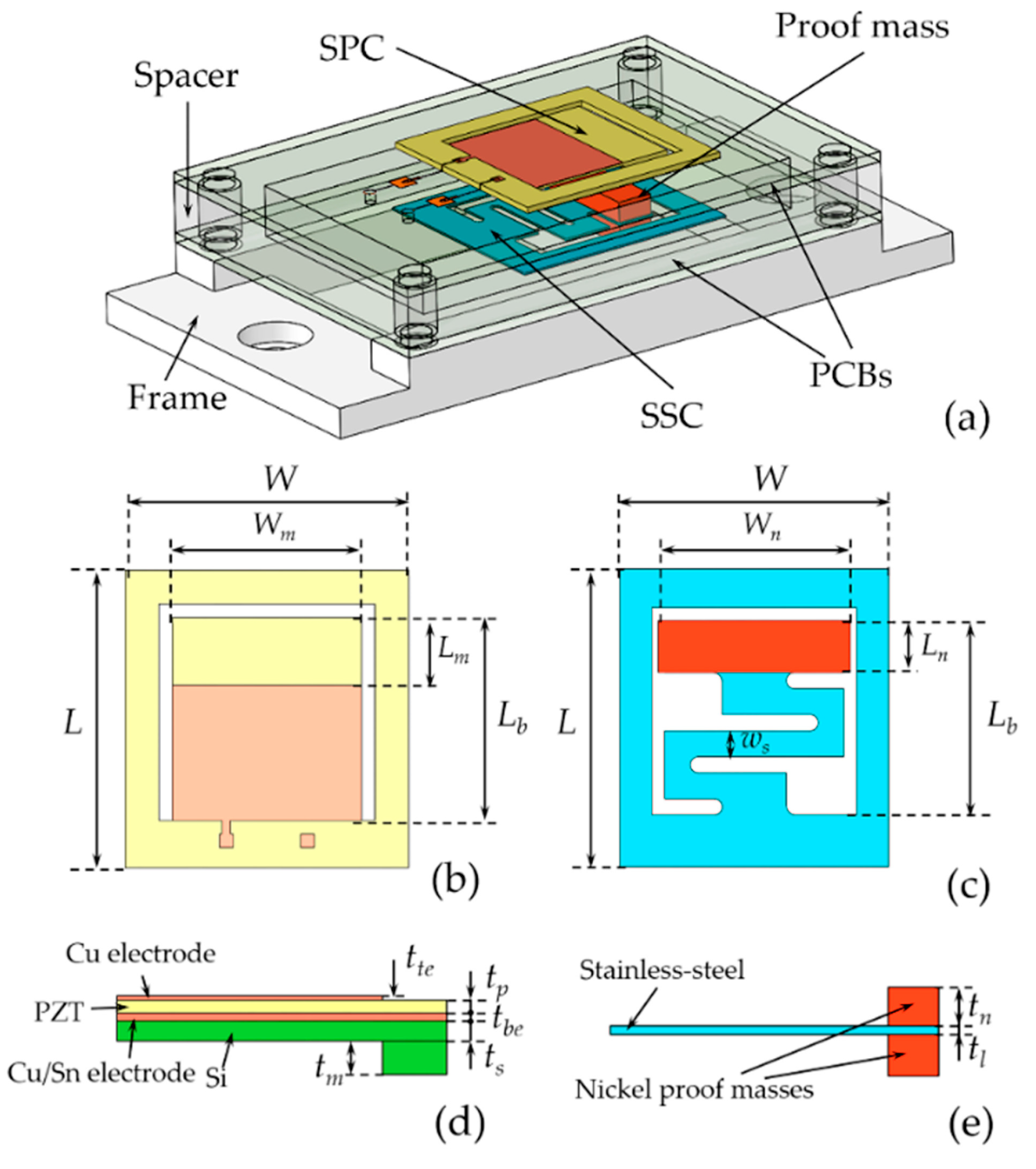
3. Low-Power Electronic Converters
3.1. Single-Phase Rectifiers
3.1.1. Half-Wave Rectifier
3.1.2. Bridge Rectifier
3.2. Voltage Multipliers (Doublers and Quadruplers)
3.2.1. Voltage Doublers
3.2.2. Voltage Quadruplers
3.2.3. Maximum Point Power Tracking
3.3. Switching DC/DC Regulators
3.3.1. Structure and Operational Principle of Step-Down Converters
3.3.2. Structure and Operational Principle of Step-Up Converters
4. Conventional Parallel-Plate Capacitors and Thin-Film Supercapacitors—Equivalent Circuits and Basic Parameters
4.1. Conventional Parallel-Plate Capacitors
4.2. Thin-Film Ultra-Capacitors (or Supercapacitors)
5. Comparative Analysis of Vibrational Energy Harvesting Systems
| Parameter | (Tabesh et al.) [60] | (Ramadass et al.) [86] | (Hehn et al.) [95] | (Kwon et al.) [91] | (Romani et al.) [7] | (Aktakka et al.) [8] | (Liu et al.) [9] | (Sanchez et al.) [81] | (Wu et al.) [82] | (Du et al.) [53] |
|---|---|---|---|---|---|---|---|---|---|---|
| Piezoelectric Element | ||||||||||
| Type of PEH | Q220-A4-303YB | MIDE V22B | MIDE V22B | MIDE V22B | Three cantilevered Q220-A4-303YB | Custom MEMS harvester, 27 mm3 | Custom MEMS harvester, 150 mm3 | MIDE V21B and V22B | MIDE V22B | MIDE V21BL |
| Excitation frequency | 250 Hz | 225 Hz | 174 Hz | 143 Hz | 40 Hz | 155 Hz | 4–5 Hz | 225 Hz | 144 Hz | 92 Hz |
| Maximum average power (or raw power) | >500 μW (2.3 g) | n.a. | 557 μW | 80 μW | 405 μW | 95 μW | 400 μW | n.a. | n.a. | n.a. |
| Piezoelectric capacitance | 52 nF | 12 nF | 19.5 nF | 15 nF | 52 nF | 8.5 nF | 25 nF | 26 nF | 19 nF | 45 nF |
| Open-circuit voltage amplitude | 3–20 V | 2.4 V | 12.6 V | 2.6 V | 20 V | 1.8 V | 6 V | 2.5 V | 4.9 V | 2.5 V |
| Piezoelectric material | PZT-5A4E | PZT-5H | PZT-5H | PZT-5H | PZT-5A | PZT | Micro-Fiber Composite (MFC) materials | PZT-5A and PZT-5H | PZT-5H | PZT-5H |
| Controlling circuit | ||||||||||
| Conversion circuit | Voltage-doubler rectifier; buck converter; analog controller | Diode bridge; bias flip rectifier; DC-DC buck regulator | pNVC (5); active diode; series SECE | Energy-investing switched-inductor AC-DC converter | Diode bridge; single SECE (2) for three PEHs | Bias clip stage; NVC; active diode; trickle battery charger | LTC3588-1 extraction circuit; battery charger system LTC4071 | Parallel-SSHI rectifier; DC-DC converter; LDO | SSHI circuit and an active rectifier | Diode bridge; SSHC (3) for PEH |
| Type of realization | Discrete components | Process: 350 nm CMOS; chip area: 4.3 mm2 | Process: 350 nm CMOS; chip area: 1.25 mm2 | Process: 180 nm CMOS; chip area: 2.3 mm2 | Discrete components | Process: 180 nm CMOS; chip area: 0.3 mm2 | Discrete components | Process: 350 nm CMOS; chip area: 1.17 mm2 | Process: 250 nm BiCMOS; chip area: 0.98 × 0.76 mm2 | Process: 350 nm CMOS; chip area: 2.9 mm2 |
| Power consumption | <50 μW | <2 μW | 1.7–4.7 μW | 2–3 μW | 8–18 μW | 0.5 μW (active); 10 pW (sleep) | <2 μW | 1 mW (active); 4 μW (sleep) | 11.5 μW | ≈1.7 μW |
| Output DC voltage | 7.5 V | 1.8 V | 5 V | 3.7 V | 6.5 V | 1.8 V | 1.8 V | 0.7–5 V regulated | up to 5 V | up to 6 V |
| Output power | 0.5 mW | 32.5 μW | 10–100 μW | ≈50 μW | 300 μW | 94.5 μW | 200 mW | ≈160 μW | 136 μW | 161.8 μW |
| FoM (through Equation (36)) | n.a. | n.a. | up to 3.45 | n.a. | n.a. | n.a. | up to 4.38 | 2.07 | up to 6.25 | |
| Cold start-up | Yes | No | No | No | Yes | Yes | Yes | Yes | Yes | Yes |
| Maximum overall electrical energy efficiency | 60% | 85% (4) | 85% | 69% (4) | 50–74% | 58–86% (4) | >30% | 94% | 85% | 80% |
| Start-up requirements | Self-powered; battery at the output port (1) | Self-powered; battery at the output port (1) | Self-powered; capacitor at the output port | Self-powered; battery at the output port (1) | Self-powered; capacitor 33 μF at the output port (1) | Self-powered; supercapacitor 20 mF at the output port (1) | Self-powered; battery at the output port (1) | Self-powered; storage capacitor 200 μF at the output port (1) | Self-powered; rechargeable battery at the output port (1) | Self-powered; supercapacitor 2.5 mF at the output port (1) |
| Year | 2010 | 2010 | 2012 | 2014 | 2014 | 2014 | 2015 | 2016 | 2017 | 2017 |
| Parameter | (Du et al.) [93] | (Peng et al.) [89] | (Du et al.) [88] | (Li et al.) [87] | (Chew et al.) [59] | (Chamanian et al.) [92] | (Çiftci et al.) [84] | (Chamanian et al.) [83] | (Huet et al.) [11] | (Ben Ammar et al.) [85] | (Costanzo et al.) [94] |
|---|---|---|---|---|---|---|---|---|---|---|---|
| Piezoelectric Element | |||||||||||
| Type of PEH | Custom MEMS harvester, 1.0 g | MIDE PPA1022 | Custom MEMS harvester, 1.0 g | MIDE PPA1021 and PPA1011 | 1 Smart Material MFC8528-P2 | Q220-A4-303YB | Custom MEMS harvester with a footprint of 36 mm2 | MIDE V22BL | MIDE PPA 1014 | AB4113BLW100-R | MIDE PPA-4011 |
| Excitation frequency | 219 Hz | 53–85 Hz | 219 Hz | 100–140 Hz | 10 Hz (min) | 317 Hz | 450 Hz | 208 Hz | <100 Hz | 1 Hz | 232 Hz |
| Maximum average power (or raw power) | 186 μW | n.a. | 186 μW | 160–200 μW | 3.96 μW | n.a. | n.a. | n.a. | n.a. | 4.32 mW | n.a. |
| Piezoelectric capacitance | 1.94 nF | 8 nF | 1.94 nF | 20 and 100 nF | n.a. | 2 nF | 2 nF | 4.66 nF | <55 nF | 150 nF | n.a. |
| Open-circuit voltage amplitude | up to 4.2 V | 0.85–2.13 V | up to 7 V | 1.6–2.66 V | 1.2–20 V | 1.12 V | <3.2 V | 0.87 V | <8 V | 7.2 V | <2 V |
| Piezoelectric material | N/A | PZT-5H | N/A | PZT-5H | Micro-Fiber Composite (MFC) material | PZT-5A | N/A | PZT-5H | PZT-5H | PZT | PZT-5H |
| Controlling circuit | |||||||||||
| Conversion circuit | Cold start-up SSHI interface circuit and full-bridge rectifier | Sense-and- set (SaS) rectifier with a static power of 7 nW | Split-electrode SSHC (SE-SSHC) rectifier | Parallel-SSHI rectifier; buck/boost DC-DC converter | Voltage doubler; analog control circuit LTC3388-3 buck converter and LTC2934-2 | Self-adapting synchronized-switch harvesting (SA-SSH) interface circuit | SSHC circuit utilizing a flipping inductor; DC-DC converter; LDO | Enhanced SSHI system (used external inductor in the range of μHs) | LTC3588-1 extraction circuit; balancing system ALD810023 for ultra-caps | Interface circuit for footstep | Energy Harvester Power Optimizer (EHPO) |
| Type of realization | Process: 180 nm CMOS; chip area: 0.2 mm2 | Process: 180 nm CMOS; chip area: 0.47 mm2 | Process: 180 nm CMOS; chip area: 3.9 mm2 | Process: 130 nm CMOS; chip area: 1.07 mm2 | Discrete components | Process: 180 nm CMOS; chip area: 0.6 × 0.9 mm | Process: 180 nm CMOS; chip area: 1.23 mm2 | Process: 180 nm CMOS; chip area: 0.28 mm2 | Discrete components | Discrete components | Discrete components |
| Power consumption | 0.359 μW (1) | ≈10 μW (1) | ≈2.9 μW (1) | 5 μW (1) | ≤80 μW | 1.3 μW | ≈18 μW (1) | 3.84–26.37 μW | 50 μW | n.a. | n.a. |
| Output DC voltage | 1.5 V | up to 2 V | up to 6 V | ≤3 V | ≤3.3 V | up to 4 V | ≤3 V | 2.68 V optimum value | 2.8–3.6 V | 3.6 V | n.a |
| Output power | 30 μW | 15 μW | 16.1 μW | 120–200 μW | n.a. | 3.22 μW | 24.2 μW | 3.84 μW | 213.2 mW | 4.32 mW | 2.81 mW |
| FoM (through Equation (36)) | n.a. | up to 7.8 | n.a. | 8.47 | n.a. | 4.04 | 2.62 | up to 5.23 | n.a. | n.a. | n.a. |
| Cold start-up | Yes | Yes | Yes | Yes | Yes | Yes | Yes | Yes | Yes | Yes | Yes |
| Maximum overall electrical energy efficiency | 50% | 42% | >80% | 78% | n.a. | n.a. | 83% (L = 100 μH) | 93% (L = 820 μH) | 36% | 83.33% | n.a. |
| Start-up requirements | Self-powered; storage capacitor at the output port (2) | Self-powered; battery at the output port (2) | Self-powered; storage capacitor at the output port (2) | Self-powered; supercapacitor 4.7 mF at the output port (2) | Self-powered; supercapacitor 22 mF at the output port (2) | Self-powered; capacitor 1 μF at the output port (2) | Self-powered; storage capacitor 453 nF at the output port (2) | Self-powered; storage capacitor 449 nF at the output port (2) | Self-powered; supercapacitors 8 × 1 F at the output port (2) | Self-powered; supercapacitor 1.0 mF at the output port (2) | n.a. |
| Year | 2018 | 2019 | 2019 | 2019 | 2020 | 2020 | 2021 | 2021 | 2022 | 2023 | 2023 |
6. Practical Realizations of Piezoelectric Power Conversion Circuits
6.1. Examples of Comercially Avaliable Monolithic Micro-Power Electronic AC-DC Converters
6.2. Examples of Custom Micro-Power Electronic AC-DC Converters
7. Concluding Remarks
Author Contributions
Funding
Data Availability Statement
Acknowledgments
Conflicts of Interest
References
- Todaro, M.T.; Guido, F.; Algieri, L.; Mastronardi, V.M.; Desmaële, D.; Epifani, G.; De Vittorio, M. Biocompatible, Flexible, and Compliant Energy Harvesters Based on Piezoelectric Thin Films. IEEE Trans. Nanotechnol. 2018, 17, 220–230. [Google Scholar] [CrossRef]
- Amin, N.; Islam, S.K. Energy Harvesting in Implantable and Wearable Medical Devices for Enduring Precision Healthcare. Energies 2022, 15, 7495. [Google Scholar] [CrossRef]
- Fu, H.; Jiang, J.; Hu, S.; Rao, J.; Theodossiades, S. A multi-stable ultra-low frequency energy harvester using a nonlinear pendulum and piezoelectric transduction for self-powered sensing. Mech. Syst. Signal Process. 2023, 189, 110034. [Google Scholar] [CrossRef]
- Elfrink, R.; Matova, S.; de Nooijer, C.; Jambunathan, M.; Goedbloed, M.; van de Molengraft, J.; Pop, V.; Vullers, R.J.M.; Renaud, M.; van Schaijk, R. Shock induced energy harvesting with a MEMS harvester for automotive applications. In Proceedings of the 2011 International Electron Devices Meeting, Washington, DC, USA, 5–7 December 2011; pp. 29.5.1–29.5.4. [Google Scholar] [CrossRef]
- Shimanouchi, T.; Toyoda, O.; Nakazawa, F. A wireless motor-condition, precise analysis system using a highly efficient vibration-energy harvester. In Proceedings of the 11th IEEE International Conference on Industrial Informatics (INDIN), Bochum, Germany, 29–31 July 2013. [Google Scholar] [CrossRef]
- Rosa, R.L.; Costanza, M.; Livreri, P. Advanced Techniques for Powering Wireless Sensor Nodes through Energy Harvesting and Wireless Power Transfer. In Proceedings of the 2020 AEIT International Conference of Electrical and Electronic Technologies for Automotive (AEIT AUTOMOTIVE), Turin, Italy, 18–20 November 2020. [Google Scholar] [CrossRef]
- Romani, A.; Filippi, M.; Tartagni, M. Micropower Design of a Fully Autonomous Energy Harvesting Circuit for Arrays of Piezoelectric Transducers. IEEE Trans. Power Electron. 2014, 29, 729–739. [Google Scholar] [CrossRef]
- Aktakka, E.E.; Najafi, K. A Micro Inertial Energy Harvesting Platform with Self-Supplied Power Management Circuit for Autonomous Wireless Sensor Nodes. IEEE J. Solid-State Circuits 2014, 49, 2017–2029. [Google Scholar] [CrossRef]
- Liu, W.; Wang, Z.; Qu, S.; Luo, R. Vibration energy harvesting and management for wireless sensor networks in bridge structural monitoring. In Proceedings of the 2015 IEEE SENSORS, Busan, Republic of Korea, 1–4 November 2015. [Google Scholar] [CrossRef]
- Han, Y.; Feng, Y.; Yu, Z.; Lou, W.; Liu, H. A Study on Piezoelectric Energy-Harvesting Wireless Sensor Networks Deployed in a Weak Vibration Environment. IEEE Sens. J. 2017, 17, 6770–6777. [Google Scholar] [CrossRef]
- Huet, F.; Boitier, V.; Seguier, L. Tunable Piezoelectric Vibration Energy Harvester with Supercapacitors for WSN in an Industrial Environment. IEEE Sens. J. 2022, 22, 15373–15384. [Google Scholar] [CrossRef]
- Caliò, R.; Rongala, U.B.; Camboni, D.; Milazzo, M.; Stefanini, C.; De Petris, G.; Oddo, C.M. Piezoelectric Energy Harvesting Solutions. Sensors 2014, 14, 4755–4790. [Google Scholar] [CrossRef] [PubMed]
- Li, H.; Tian, C.; Deng, D. Energy harvesting from low frequency applications using piezoelectric materials. Appl. Phys. Rev. 2014, 1, 041301. [Google Scholar] [CrossRef]
- Priya, S.; Song, H.-C.; Zhou, Y.; Varghese, R.; Chopra, A.; Kim, S.-G.; Kanno, I.; Wu, L.; Ha, D.S.; Ryu, J.; et al. A Review on Piezoelectric Energy Harvesting: Materials, Methods, and Circuits. Energy Harvest. Syst. Actuators 2017, 4, 3–39. [Google Scholar] [CrossRef]
- Covaci, C.; Gontean, A. Piezoelectric Energy Harvesting Solutions: A Review. Sensors 2020, 20, 3512. [Google Scholar] [CrossRef] [PubMed]
- Tamburrano, P.; Sciatti, F.; Plummer, A.R.; Distaso, E.; De Palma, P.; Amirante, R. A Review of Novel Architectures of Servovalves Driven by Piezoelectric Actuators. Energies 2021, 14, 4858. [Google Scholar] [CrossRef]
- Brusa, E.; Carrera, A.; Delprete, C. A Review of Piezoelectric Energy Harvesting: Materials, Design, and Readout Circuits. Actuators 2023, 12, 457. [Google Scholar] [CrossRef]
- Mishra, P.; Singh, G. Energy Management Systems in Sustainable Smart Cities Based on the Internet of Energy: A Technical Review. Energies 2023, 16, 6903. [Google Scholar] [CrossRef]
- Hezekiah, J.D.K.; Ramya, K.C.; Radhakrishnan, S.B.K.; Kumarasamy, V.M.; Devendran, M.; Ramalingam, A.; Maheswar, R. Review of Next-Generation Wireless Devices with Self-Energy Harvesting for Sustainability Improvement. Energies 2023, 16, 5174. [Google Scholar] [CrossRef]
- Dziadak, B.; Makowski, Ł.; Kucharek, M.; Jóśko, A. Energy Harvesting for Wearable Sensors and Body Area Network Nodes. Energies 2023, 16, 1681. [Google Scholar] [CrossRef]
- Katche, M.L.; Makokha, A.B.; Zachary, S.O.; Adaramola, M.S. A Comprehensive Review of Maximum Power Point Tracking (MPPT) Techniques Used in Solar PV Systems. Energies 2023, 16, 2206. [Google Scholar] [CrossRef]
- Nwalike, E.D.; Ibrahim, K.A.; Crawley, F.; Qin, Q.; Luk, P.; Luo, Z. Harnessing Energy for Wearables: A Review of Radio Frequency Energy Harvesting Technologies. Energies 2023, 16, 5711. [Google Scholar] [CrossRef]
- Haider, S.T.; Shah, M.A.; Lee, D.-G.; Hur, S. A Review of the Recent Applications of Aluminum Nitride-Based Piezoelectric Devices. IEEE Access 2023, 11, 58779–58795. [Google Scholar] [CrossRef]
- Ottman, G.K.; Hofmann, H.F.; Bhatt, A.C.; Lesieutre, G.A. Adaptive piezoelectric energy harvesting circuit for wireless remote power supply. IEEE Trans. Power Electron. 2002, 17, 669–676. [Google Scholar] [CrossRef]
- Tabesh, A.; Fréchette, L. An improved small-deflection electromechanical model for piezoelectric bending beam actuators and energy harvesters. J. Micromechanics Microengineering 2008, 18, 104009. [Google Scholar] [CrossRef]
- Sezer, N.; Koç, M. A comprehensive review on the state-of-the-art of piezoelectric energy harvesting. Nano Energy 2021, 80, 105567. [Google Scholar] [CrossRef]
- Wei, C.; Jing, X. A comprehensive review on vibration energy harvesting: Modelling and realization. Renew. Sustain. Energy Rev. 2017, 74, 1–18. [Google Scholar] [CrossRef]
- Liang, J.; Liao, W.-H. Impedance matching for improving piezoelectric energy harvesting systems. In Proceedings of the SPIE—The International Society for Optical Engineering, San Diego, CA, USA, 6–10 March 2010. [Google Scholar] [CrossRef]
- ABT-441-RC; Piezo Element, 27 mm, 4200 Hz, Leaded—Datasheet. MULTICOMP PRO: Chicago, IL, USA. 2020. Available online: https://uk.farnell.com/multicomp/abt-441-rc/transducer-piezo-4200hz-30v/dp/1675548 (accessed on 11 September 2023).
- ABT-448-90-RC; Piezo Element, 35 mm, 2900 Hz, Leaded—Datasheet. MULTICOMP PRO: Chicago, IL, USA. 2019. Available online: https://uk.farnell.com/multicomp/abt-448-90-rc/piezo-element-35mm-2-900hz-leaded/dp/1675549?ost=abt-448-90-rc (accessed on 11 September 2023).
- PPA PRODUCTS Datasheet & User Manual; Midé Technology: Medford, MA, USA. 2020. Available online: https://cdn2.hubspot.net/hubfs/3841176/Data-Sheets/ppa-piezo-product-datasheet.pdf (accessed on 27 May 2024).
- Wakshume, D.G.; Płaczek, M.Ł. Optimizing Piezoelectric Energy Harvesting from Mechanical Vibration for Electrical Efficiency: A Comprehensive Review. Electronics 2024, 13, 987. [Google Scholar] [CrossRef]
- He, M.; He, M.; Zhang, X.; Xia, L. Topology Optimization of Piezoelectric Energy Harvesters for Enhanced Open-Circuit Voltage Subjected to Harmonic Excitations. Materials 2022, 15, 4423. [Google Scholar] [CrossRef]
- Safaei, M.; Sodanoand, H.A.; Anton, S.R. A review of energy harvesting using piezoelectric materials: State-of-the-art a decade later (2008–2018). Smart Mater. Struct. 2019, 28, 113001. [Google Scholar] [CrossRef]
- Ichige, R.; Kuriyama, N.; Umino, Y.; Tsukamoto, T.; Suzuki, T. Size optimization of metamaterial structure for elastic layer of a piezoelectric vibration energy harvester. Sens. Actuators A Phys 2021, 318, 112488. [Google Scholar] [CrossRef]
- Elvira-Hernández, E.A.; Woo-García, R.M.; López-Huerta, F.; Vázquez-Leal, H.; Herrera-May, A.L. Design of a MEMS-Based Piezoelectric Vibration Energy Harvesting Device for Automotive Applications. Comput. Sist. 2019, 23, 71–79. [Google Scholar] [CrossRef]
- Stamatellou, A.M. PZT and PVDF piezoelectric transducers’ design implications on their efficiency and energy harvesting potential. Energy Harvest. Syst. 2023, 10, 157–167. [Google Scholar] [CrossRef]
- Feng, H.; Bu, L.; Li, Z.; Xu, S.; Hu, B.; Xu, M.; Jiang, S.; Wang, X. Multimodal MEMS vibration energy harvester with cascaded flexible and silicon beams for ultralow frequency response. Microsyst. Nanoeng. 2023, 9, 33. [Google Scholar] [CrossRef]
- Zhang, L.; Gui, J.; Wu, Z.; Li, R.; Wang, Y.; Gong, Z.; Zhao, X.; Sun, C.; Guo, S. Enhanced performance of piezoelectric nanogenerator based on aligned nanofibers and three-dimensional interdigital electrodes. Nano Energy 2019, 65, 103924. [Google Scholar] [CrossRef]
- Huang, M.; Hou, C.; Li, Y.; Liu, H.; Wang, F.; Chen, T.; Yang, Z.; Tang, G.; Sun, L. A Low-Frequency MEMS Piezoelectric Energy Harvesting System Based on Frequency Up-Conversion Mechanism. Micromachines 2019, 10, 639. [Google Scholar] [CrossRef] [PubMed]
- Hossain, M.I.; Zahid, M.S.; Chowdhury, M.A.; Hossain MM, M.; Hossain, N. MEMS-based energy harvesting devices for low-power applications—A review. Results Eng. 2023, 19, 101264. [Google Scholar] [CrossRef]
- Zhang, M.; Zhang, A.M.; Chen, Y.; Xie, J.; Xin, Z.F.; Chen, Y.J.; Kan, Y.H.; Li, S.L.; Lan, Y.Q.; Zhang, Q. Polyoxovanadate-polymer hybrid electrolyte in solid state batteries. Energy Storage Mater. 2020, 29, 172–181. [Google Scholar] [CrossRef]
- Dutta, S.; Pandey, A. Overview of residual stress in MEMS structures: Its origin, measurement, and control. J. Mater. Sci. Mater. Electron. 2021, 32, 6705–6741. [Google Scholar] [CrossRef]
- Aleksandrova, M. Polymeric seed layer as a simple approach for nanostructuring of Ga-doped ZnO films for flexible piezoelectric energy harvesting. Microelectron. Eng. 2020, 233, 111434. [Google Scholar] [CrossRef]
- Stefanov, N. Special rectifiers, and Power rectifiers. In Power Supply Devices; Tehnika: Sofia, Bulgaria, 2002; Chapters 2 and 4; pp. 43–68, 84–96. ISBN 9789540305646. (In Bulgarian) [Google Scholar]
- Tietze, V.; Schenk, C. Power Supplies In Electronic circuits, 2nd ed.; Springer: New York, NY, USA, 2008; Chapter 16; pp. 885–928. [Google Scholar] [CrossRef]
- Gates Energy Products, Typical Application for Sealed Nickel-cadmium Batteries. In Rechargeable Batteries Application Handbook; Butterworth-Heinemann: Boston, MA, USA; London, UK, 1992; pp. 35–152.
- Aleksandrova, M.; Pandiev, I. Application of Thin Film Ultralow-Power Lead-Free Perovskite Solar Energy Harvesters in Power Management Systems. In Proceedings of the 28 International Conference Mixed Design of Integrated Circuits and Systems, MIXDES 2021, Łódź, Poland, 24–26 June 2021. [Google Scholar] [CrossRef]
- Asthana, P.; Khanna, G. Power amplification interface circuit for broadband piezoelectric energy harvester. Microelectron. J. 2020, 98, 104734. [Google Scholar] [CrossRef]
- Dicken, J.; Mitcheson, P.D.; Stoianov, I.; Yeatman, E.M. Power-Extraction Circuits for Piezoelectric Energy Harvesters in Miniature and Low-Power Applications. IEEE Trans. Power Electron. 2012, 27, 4514–4529. [Google Scholar] [CrossRef]
- Szarka, G.D.; Stark, B.H.; Burrow, S.G. Review of Power Conditioning for Kinetic Energy Harvesting Systems. IEEE Trans. Power Electron. 2012, 27, 803–815. [Google Scholar] [CrossRef]
- Faghihi, S.; Moallem, M. Analysis and design of a low power electronics circuit for energy harvesting applications. In Proceedings of the 2012 IEEE International Symposium on Industrial Electronics, Hangzhou, China, 28–31 May 2012. [Google Scholar] [CrossRef]
- Du, S.; Seshia, A.A. An Inductorless Bias-Flip Rectifier for Piezoelectric Energy Harvesting. IEEE J. Solid-State Circuits 2017, 52, 2746–2757. [Google Scholar] [CrossRef]
- Richard, C.; Guyomar, D.; Audigier, D.; Ching, G. Semi Passive Damping using Continuous Switching of a Piezoelectric Device. In Proceedings of the SPIE Smart Structures and Materials Conference, Passive Damping and Isolation, San Diego, CA, USA, 1–2 March 1999. [Google Scholar]
- Guyomar, D.; Richard, C.; Lefeuvre, E.; Petit, L. Piezoelectric Non-linear Systems for Standalone Vibration Control and Energy Reclamation. In Proceedings of the AC’04, Hildesheim, Germany, 27–28 April 2004. [Google Scholar]
- Badel, A.; Guyomar, D.; Lefeuvre, E.; Richard, C. Efficiency enhancement of a piezoelectric energy harvesting device in pulsed operation by synchronous charge inversion. J. Intell. Mater. Syst. Struct. 2005, 16, 889–901. [Google Scholar] [CrossRef]
- Dicken, J.; Mitcheson, P.D.; Stoianov, I.; Yeatman, E.M. Increased power output from piezoelectric energy harvesters by pre-biasing. In Proceedings of the 9th International Workshop on Micro and Nanotechnology for Power Generation and Energy Conversion Applications (PowerMEMS), Washington, DC, USA, 1–4 December 2009; pp. 75–78. [Google Scholar]
- Oh, T.; Islam, S.K.; To, G.; Mahfouz, M. Powering wearable sensors with a low-power CMOS piezoelectric energy harvesting circuit. In Proceedings of the 2017 IEEE International Symposium on Medical Measurements and Applications (MeMeA), Rochester, MN, USA, 7–10 May 2017. [Google Scholar] [CrossRef]
- Chew, Z.J.; Zhu, M. Adaptive Self-Configurable Rectifier for Extended Operating Range of Piezoelectric Energy Harvesting. IEEE Trans. Ind. Electron. 2020, 67, 3267–3276. [Google Scholar] [CrossRef]
- Tabesh, A.; Frechette, L.G. A Low-Power Stand-Alone Adaptive Circuit for Harvesting Energy From a Piezoelectric Micropower Generator. IEEE Trans. Ind. Electron. 2010, 57, 840–849. [Google Scholar] [CrossRef]
- Pandiev, I.; Aleksandrova, M.; Kolev, G. Design and Implementation of Interface Circuits Intended for Printed Piezoelectric Micropower Harvesters on Flexible Substrates. IOP Conf. Ser. Mater. Sci. Eng. 2020, 876, 012007. [Google Scholar] [CrossRef]
- Brenes, A.; Morel, A.; Juillard, J.; Lefeuvre, E.; Badel, A. Maximum power point of piezoelectric energy harvesters: A review of optimality condition for electrical tuning. Smart Mater. Struct. 2020, 29, 033001. [Google Scholar] [CrossRef]
- Du, S.; Jia, Y.; Do, C.D.; Seshia, A.A. An Efficient SSHI Interface with Increased Input Range for Piezoelectric Energy Harvesting Under Variable Conditions. IEEE J. Solid-State Circuits 2016, 51, 2729–2742. [Google Scholar] [CrossRef]
- Liu, Z.; Zhao, C.; Hu, G.; Yang, Y. A multi-degree-of-freedom triboelectric energy harvester for dual-frequency vibration energy harvesting. Mech. Syst. Signal Process. 2023, 188, 1–20. [Google Scholar] [CrossRef]
- Lefeuvre, E.; Badel, A.; Richard, C.; Petit, L.; Guyomar, D. A comparison between several vibration-powered piezoelectric generators for standalone systems. Sens. Actuators A Phys. 2006, 126, 405–416. [Google Scholar] [CrossRef]
- Seifart, M. Stromversorgung. In Analoge Schaltungen, 6th ed.; Technik: Berlin, Germany, 2003; Chapter 22; pp. 591–639. [Google Scholar]
- Farhi, S.; Papazov, S. Introduction to Electromagnetism. In Theoretical Electric Engineering, 2nd ed.; Tehnika: Sofia, Bulgaria, 1987; Chapter 1; Part 1, pp. 5–46. (In Bulgarian) [Google Scholar]
- Polymer Aluminum Solid Electrolytic Capacitors MA Series—Datasheet; Fujicon Electric Company: Kowloon, Hong Kong. 2024. Available online: http://www.fujicon.com/pdf/products/MA.pdf (accessed on 24 May 2024).
- Polymer Aluminum Solid Electrolytic Capacitors FZ Series—Datasheet. Fujicon Electric Company. Hunghom Commercial Centre, Tower A, 39 Ma Tau Wai Road, Hung Hom, Kowloon, Hong Kong. 2024. Available online: http://www.fujicon.com/pdf/products/FZ.pdf (accessed on 24 May 2024).
- Surface-Mount Ceramic Multilayer Capacitors—Datasheet. YAGEO, 3F, 233–1, Baoqiao Rd. Xindian Dist., New Taipei City 23145 Taiwan. 2024. Available online: https://www.yageo.com/upload/media/product/products/datasheet/mlcc/UPY-AC_NP0X7RX7S_6.3V-to-2KV_20.pdf (accessed on 24 May 2024).
- Halper, M.S.; Ellenbogen, J.C. Supercapacitors: A Brief Overview; MITRE Nanosystems Group: McLean, VA, USA, 2006; Available online: http://www.mitre.org/sites/default/files/pdf/06_0667.pdf (accessed on 24 May 2024).
- Sherrard, C.G.; Rolin, T.D. Solid-State Ultracapacitor Polymer Composite; National Aeronautics and Space Administration, Marshall Space Flight Center: Huntsville, AL, USA, 2022. Available online: https://ntrs.nasa.gov/citations/20220018181 (accessed on 24 May 2024).
- Yoshida, A.; Imoto, K.; Yoneda, H.; Nishimo, A. An electric double-layer capacitor with high capacitance and low resistance. IEEE Trans. Compon. Hybrids Manuf. Technol. 1992, 15, 133–138. [Google Scholar] [CrossRef]
- Bonert, R.; Zubieta, L. Measurement techniques for the evaluation of double-layer power capacitors, IAS ’97. In Proceedings of the 1997 IEEE Industry Applications Conference Thirty-Second IAS Annual Meeting, New Orleans, LA, USA, 5–9 October 1997. [Google Scholar] [CrossRef]
- Zubieta, L.; Bonert, R. Characterization of double-layer capacitors (DLCs) for power electronics applications. In Proceedings of the 1998 IEEE Industry Applications Conference. Thirty-Third IAS Annual Meeting (Cat. No.98CH36242), St. Louis, MO, USA, 12–15 October1998. [Google Scholar] [CrossRef]
- Belhachemi, F.; Rael, S.; Davat, B. A physical based model of power electric double-layer supercapacitors. In Proceedings of the 2000 IEEE Industry Applications Conference. Thirty-Fifth IAS Annual Meeting and World Conference on Industrial Applications of Electrical Energy (Cat. No.00CH37129), Rome, Italy, 8–12 October 2000. [Google Scholar] [CrossRef]
- Naguib, M.; Mochalin, V.N.; Barsoum, M.W.; Gogotsi, Y. 25th anniversary article: MXenes: A new family of two-dimensional materials. Adv. Mater. 2014, 26, 992–1005. [Google Scholar] [CrossRef]
- Xu, S.; Liu, W.; Liu, X.; Kuang, X.; Wang, X. A MXene based all-solid-state microsupercapacitor with 3D interdigital electrode. In Proceedings of the 19th International Conference on Solid-State Sensors, Actuators and Microsystems (TRANSDUCERS), Kaohsiung, Taiwan, 18–22 June 2017. [Google Scholar] [CrossRef]
- Tuzluca, F.N.; Yesilbag, Y.O.; Shafiee, F.N.; Hamidon, M.N.; Ertugrul, M. Two Dimensional Ti3C2Tx MXene Electrode For Supercapacitor Application. In Proceedings of the 2019 IEEE Regional Symposium on Micro and Nanoelectronics (RSM), Pahang, Malaysia, 21–23 August 2019. [Google Scholar] [CrossRef]
- Panda, S.; Deshmukh, K.; Pasha, S.K.K.; Theerthagiri, J.; Manickam, S.; Choi, M.Y. MXene based emerging materials for supercapacitor applications: Recent advances, challenges, and future perspectives. Coord. Chem. Rev. 2022, 462, 214518. [Google Scholar] [CrossRef]
- Sanchez, D.A.; Leicht, J.; Jodka, E.; Fazel, E.; Manoli, Y. 21.2 A 4 µW-to-1 mW parallel-SSHI rectifier for piezoelectric energy harvesting of periodic and shock excitations with inductor sharing, cold start-up and up to 681% power extraction improvement. In Proceedings of the 2016 IEEE International Solid-State Circuits Conference (ISSCC), San Francisco, CA, USA, 31 January–4 February 2016. [Google Scholar] [CrossRef]
- Wu, L.; Do, X.-D.; Lee, S.-G.; Ha, D.S. A Self-Powered and Optimal SSHI Circuit Integrated with an Active Rectifier for Piezoelectric Energy Harvesting. IEEE Trans. Circuits Syst. I Regul. Pap. 2017, 64, 537–549. [Google Scholar] [CrossRef]
- Chamanian, S.; Çiftci, B.; Muhtaroğlu, A.; Külah, H. A Self-Powered and Area Efficient SSHI Rectifier for Piezoelectric Harvesters. IEEE Access 2021, 9, 117703–117713. [Google Scholar] [CrossRef]
- Çiftci, B.; Chamanian, S.; Koyuncuoğlu, A.; Muhtaroğlu, A.; Külah, H. A Low-Profile Autonomous Interface Circuit for Piezoelectric Micro-Power Generators. IEEE Trans. Circuits Syst. I Regul. Pap. 2021, 68, 1458–1471. [Google Scholar] [CrossRef]
- Ben Ammar, M.; Sahnoun, S.; Fakhfakh, A.; Viehweger, C.; Kanoun, O. Self-Powered Synchronized Switching Interface Circuit for Piezoelectric Footstep Energy Harvesting. Sensors 2023, 23, 1830. [Google Scholar] [CrossRef] [PubMed]
- Ramadass, Y.K.; Chandrakasan, A.P. An Efficient Piezoelectric Energy Harvesting Interface Circuit Using a Bias-Flip Rectifier and Shared Inductor. IEEE J. Solid-State Circuits 2010, 45, 189–204. [Google Scholar] [CrossRef]
- Li, S.; Roy, A.; Calhoun, B.H. A Piezoelectric Energy-Harvesting System with Parallel-SSHI Rectifier and Integrated MPPT Achieving 417% Energy-Extraction Improvement and 97% Tracking Efficiency. In Proceedings of the 2019 Symposium on VLSI Circuits, Kyoto, Japan, 9–14 June 2019. [Google Scholar] [CrossRef]
- Du, S.; Jia, Y.; Zhao, C.; Amaratunga GA, J.; Seshia, A.A. A Fully Integrated Split-Electrode SSHC Rectifier for Piezoelectric Energy Harvesting. IEEE J. Solid-State Circuits 2019, 54, 1733–1743. [Google Scholar] [CrossRef]
- Peng, Y.; Choo, K.D.; Oh, S.; Lee, I.; Jang, T.; Kim, Y.; Lim, J.; Blaauw, D.; Sylvester, D. An Efficient Piezoelectric Energy Harvesting Interface Circuit Using a Sense-and-Set Rectifier. IEEE J. Solid-State Circuits 2019, 54, 3348–3361. [Google Scholar] [CrossRef]
- Khan, M.B.; Saif, H.; Lee, Y. A Piezoelectric Energy Harvesting Interface for Irregular High Voltage Input with Partial Electric Charge Extraction with 3.9× Extraction Improvement. In Proceedings of the 2019 IEEE Asian Solid-State Circuits Conference (A-SSCC), Macau, Macao, 4–6 November 2019. [Google Scholar] [CrossRef]
- Kwon, D.; Rincón-Mora, G.A. A Single-Inductor 0.35 µm CMOS Energy-Investing Piezoelectric Harvester. IEEE J. Solid-State Circuits 2014, 49, 2277–2291. [Google Scholar] [CrossRef]
- Chamanian, S.; Muhtaroğlu, A.; Külah, H. A Self-Adapting Synchronized-Switch Interface Circuit for Piezoelectric Energy Harvesters. IEEE Trans. Power Electron. 2020, 35, 901–912. [Google Scholar] [CrossRef]
- Du, S.; Amaratunga GA, J.; Seshia, A.A. A Cold-Startup SSHI Rectifier for Piezoelectric Energy Harvesters with Increased Open-Circuit Voltage. IEEE Trans. Power Electron. 2019, 34, 263–274. [Google Scholar] [CrossRef]
- Costanzo, L.; Lo Schiavo, A.; Vitelli, M. A Self-Supplied Power Optimizer for Piezoelectric Energy Harvesters Operating under Non-Sinusoidal Vibrations. Energies 2023, 16, 4368. [Google Scholar] [CrossRef]
- Hehn, T.; Hagedorn, F.; Maurath, D.; Marinkovic, D.; Kuehne, I.; Frey, A.; Manoli, Y. A Fully Autonomous Integrated Interface Circuit for Piezoelectric Harvesters. IEEE J. Solid-State Circuits 2012, 47, 2185–2198. [Google Scholar] [CrossRef]
- LTC3588-1; Nanopower Energy Harvesting Power Supply—Datasheet. Analog Devices: Norwood, MA, USA. 2023. Available online: https://www.analog.com/en/products/ltc3588-1.html (accessed on 16 October 2023).
- ADP5092; Ultralow Power Energy Harvester PMU with MPPT and Charge Management—Datasheet. Analog Devices: Norwood, MA, USA. 2023. Available online: https://www.analog.com/en/products/adp5092.html (accessed on 16 October 2023).
- MAX20361; Small, Single-/Multi-Cell Solar Harvester with MPPT and Harvest Counter—Datasheet. Analog Devices: Norwood, MA, USA. 2023. Available online: https://www.analog.com/en/products/max20361.html (accessed on 16 October 2023).
- Edla, M.; Lim, Y.Y.; Mikio, D.; Padilla, R.V. Non-Linear Switching Circuit for Active Voltage Rectification and Ripples Reduction of Piezoelectric Energy Harvesters. Energies 2022, 15, 709. [Google Scholar] [CrossRef]
- Haseeb, A.; Edla, M.; Ucgul, M.; Santoso, F.; Deguchi, M. A Voltage Doubler Boost Converter Circuit for Piezoelectric Energy Harvesting Systems. Energies 2023, 16, 1631. [Google Scholar] [CrossRef]
- Haseeb, A.; Edla, M.; Thabet, A.M.; Deguchi, M.; Kamran, M. A Self-Powered Dual-Stage Boost Converter Circuit for Piezoelectric Energy Harvesting Systems. Energies 2023, 16, 2490. [Google Scholar] [CrossRef]
- Kamran, M.; Edla, M.; Thabet, A.M.; Haseeb, A.; Mikio, D.; Bui, V. A Self-Powered FBRJT AC-DC Conversion Circuit for Piezoelectric Energy Harvesting Systems. Energies 2023, 16, 1734. [Google Scholar] [CrossRef]
- Kamran, M.; Edla, M.; Thabet, A.M.; Mikio, D.; Bui, V. A Self-Powered VDJT AC–DC Conversion Circuit for Piezoelectric Energy Harvesting Systems. Designs 2023, 7, 94. [Google Scholar] [CrossRef]
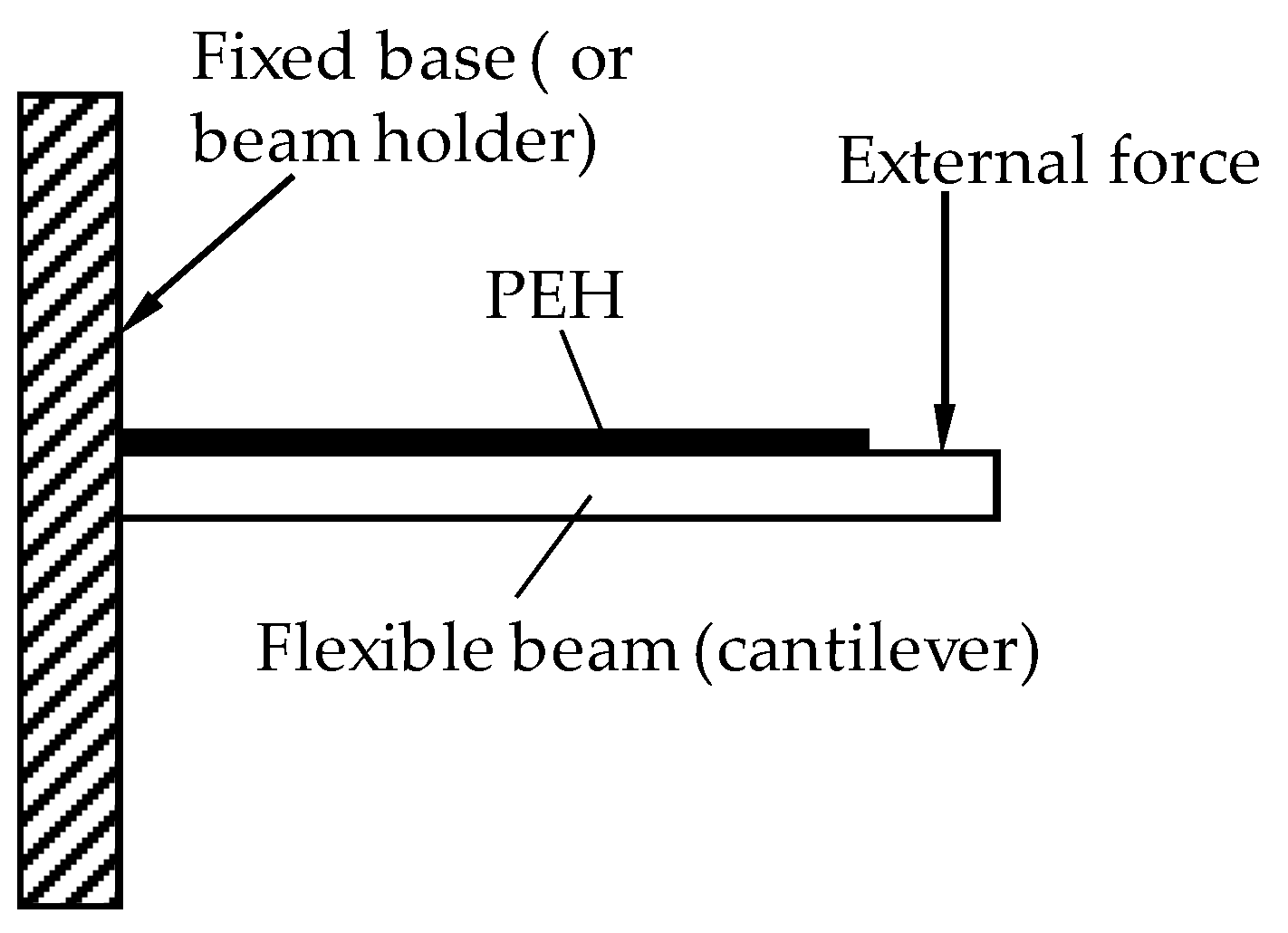


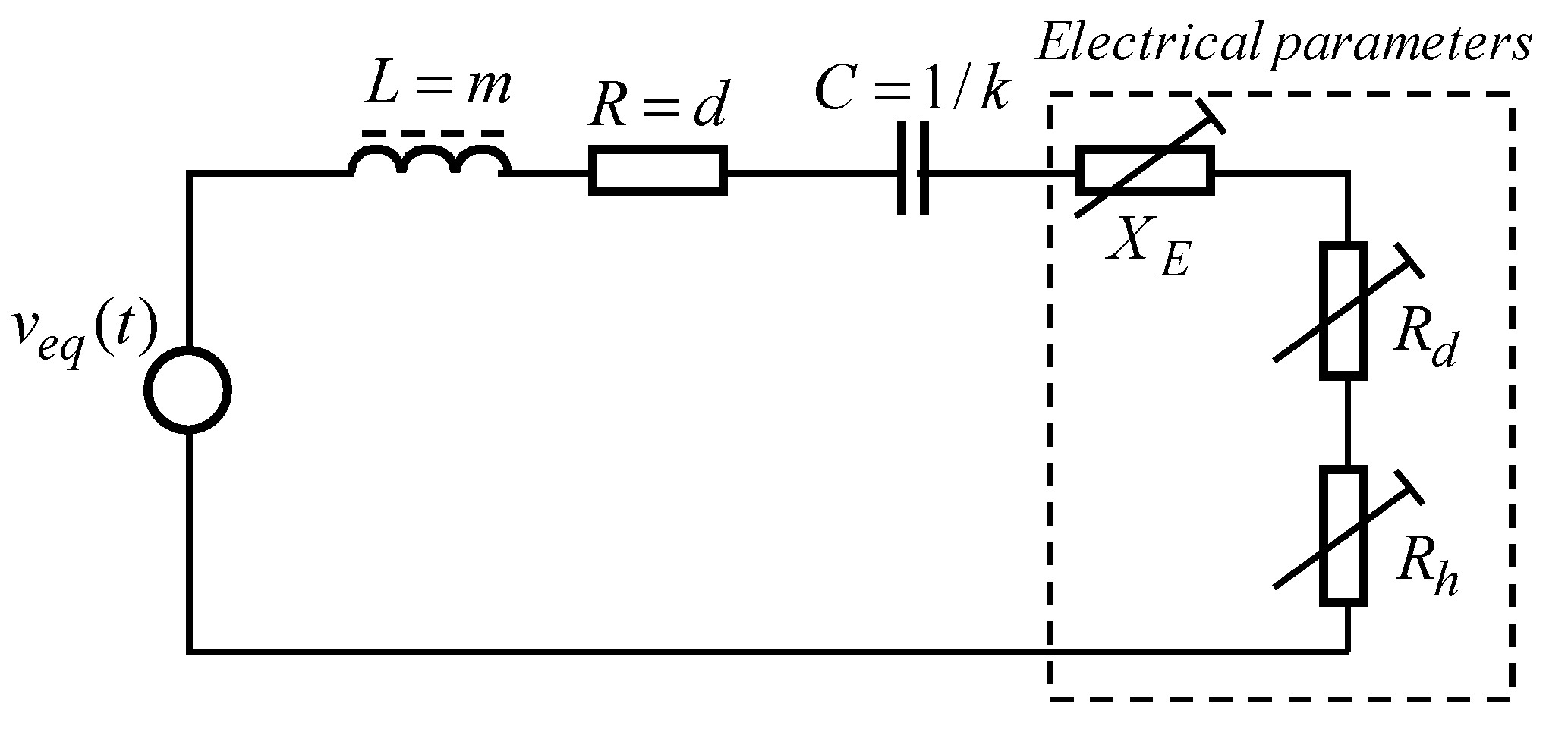
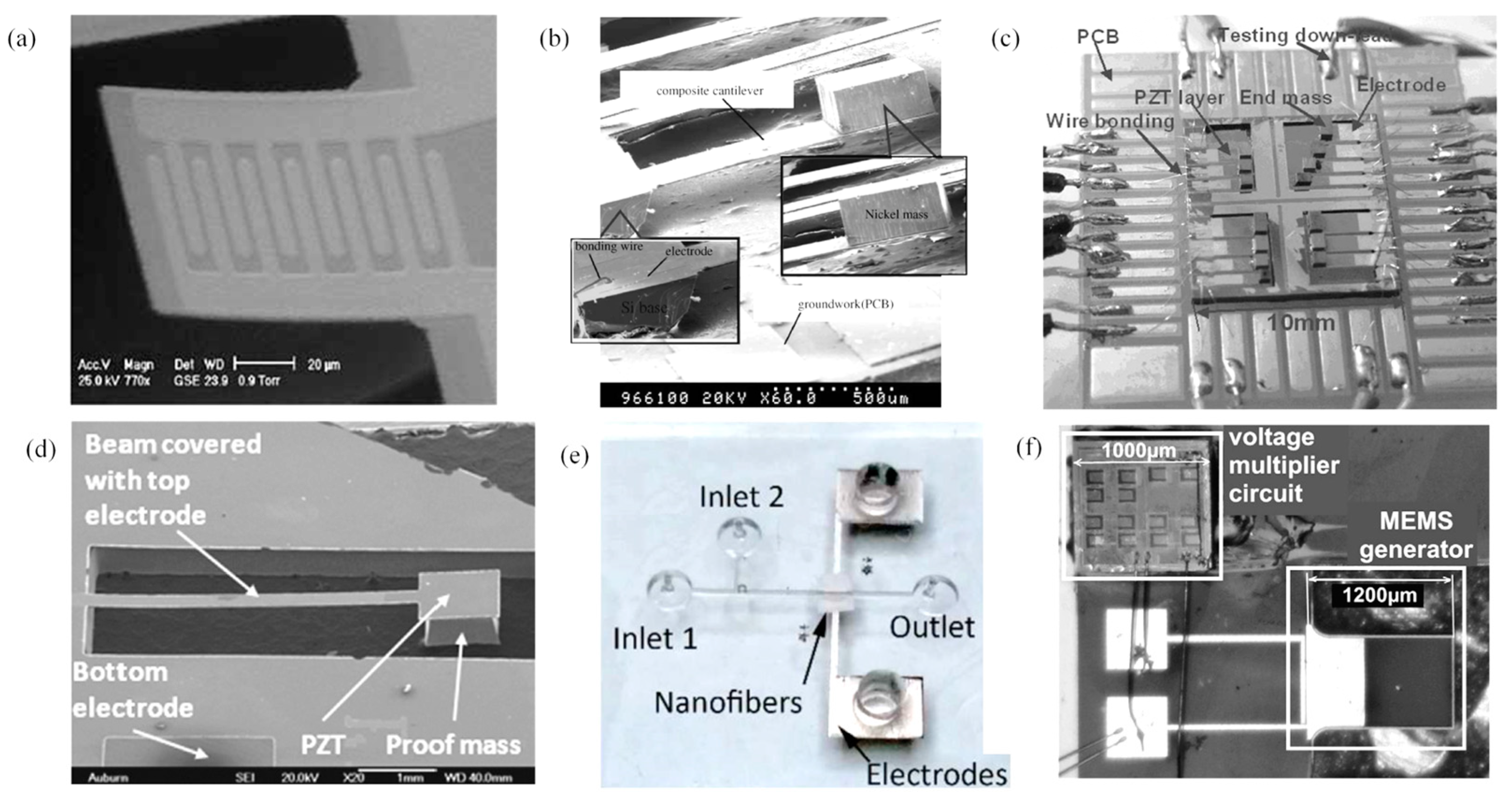
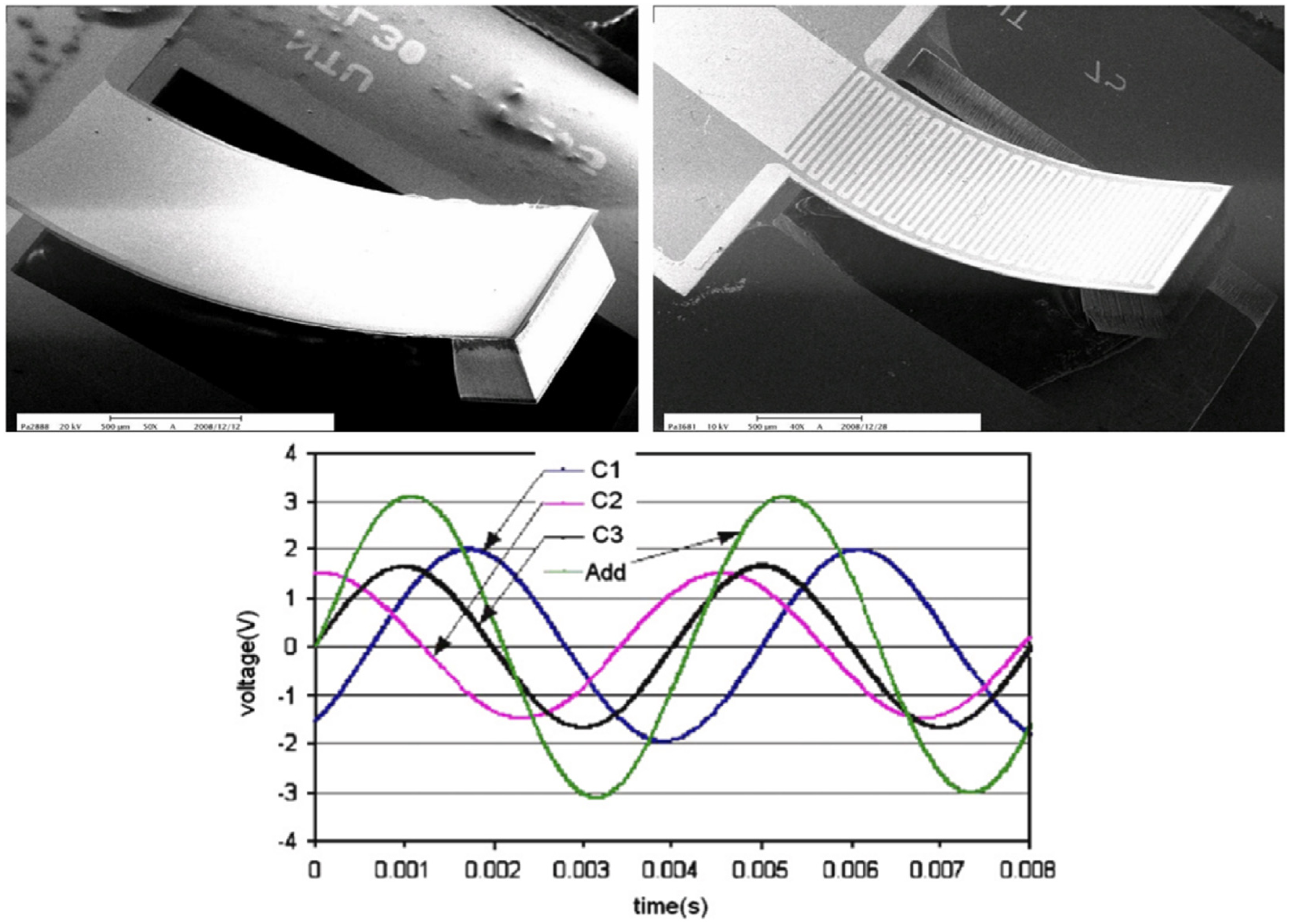


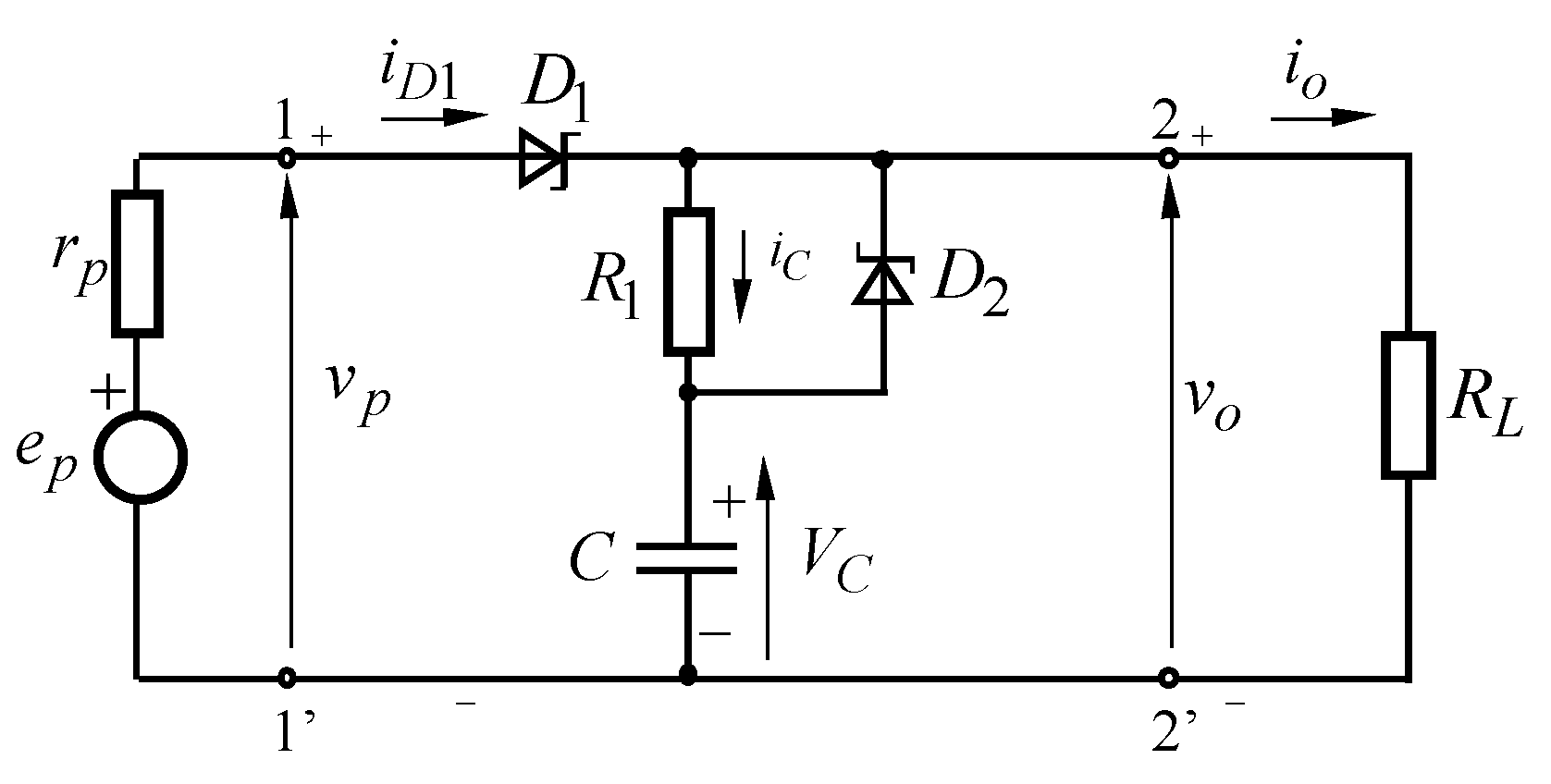



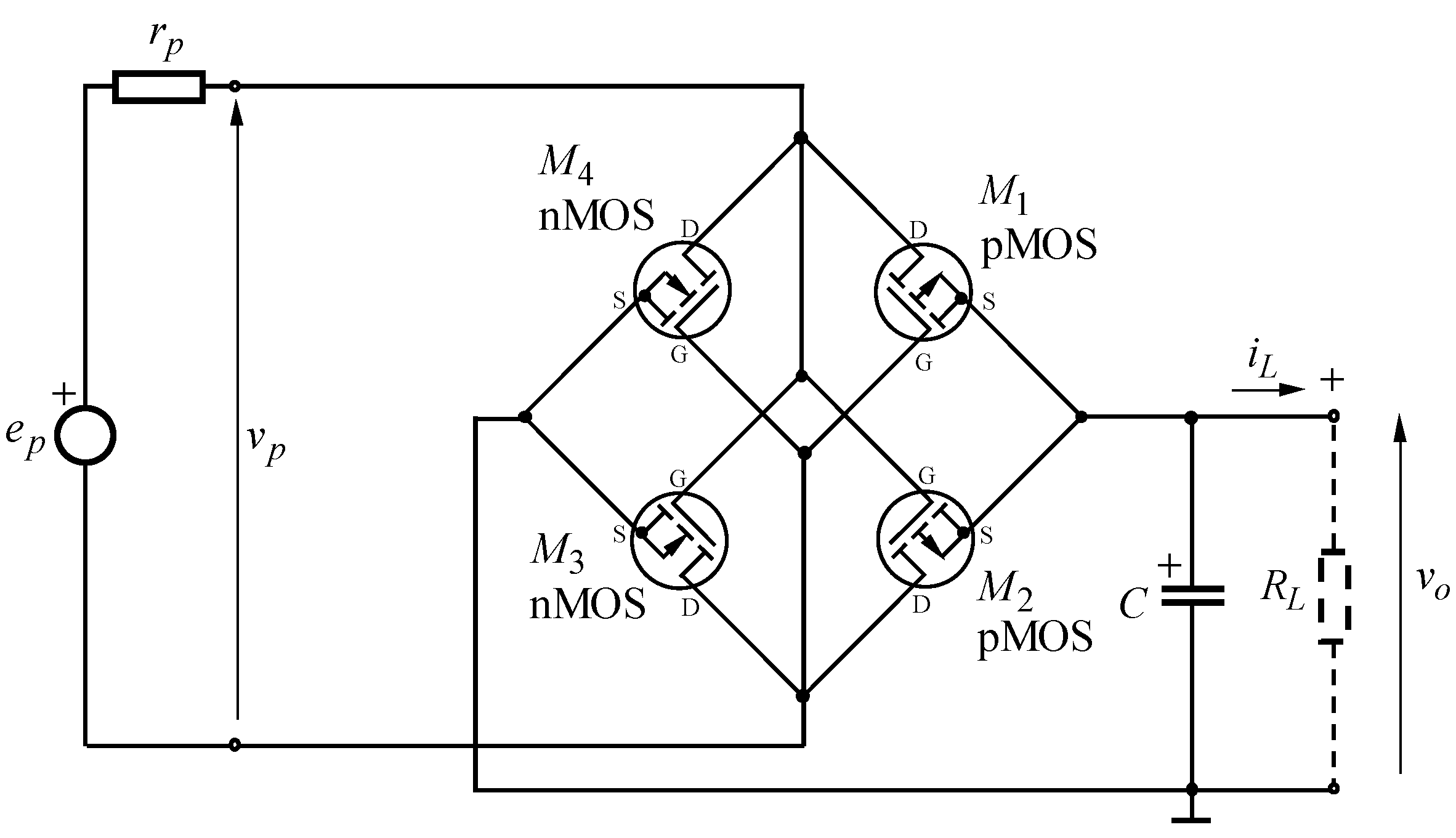
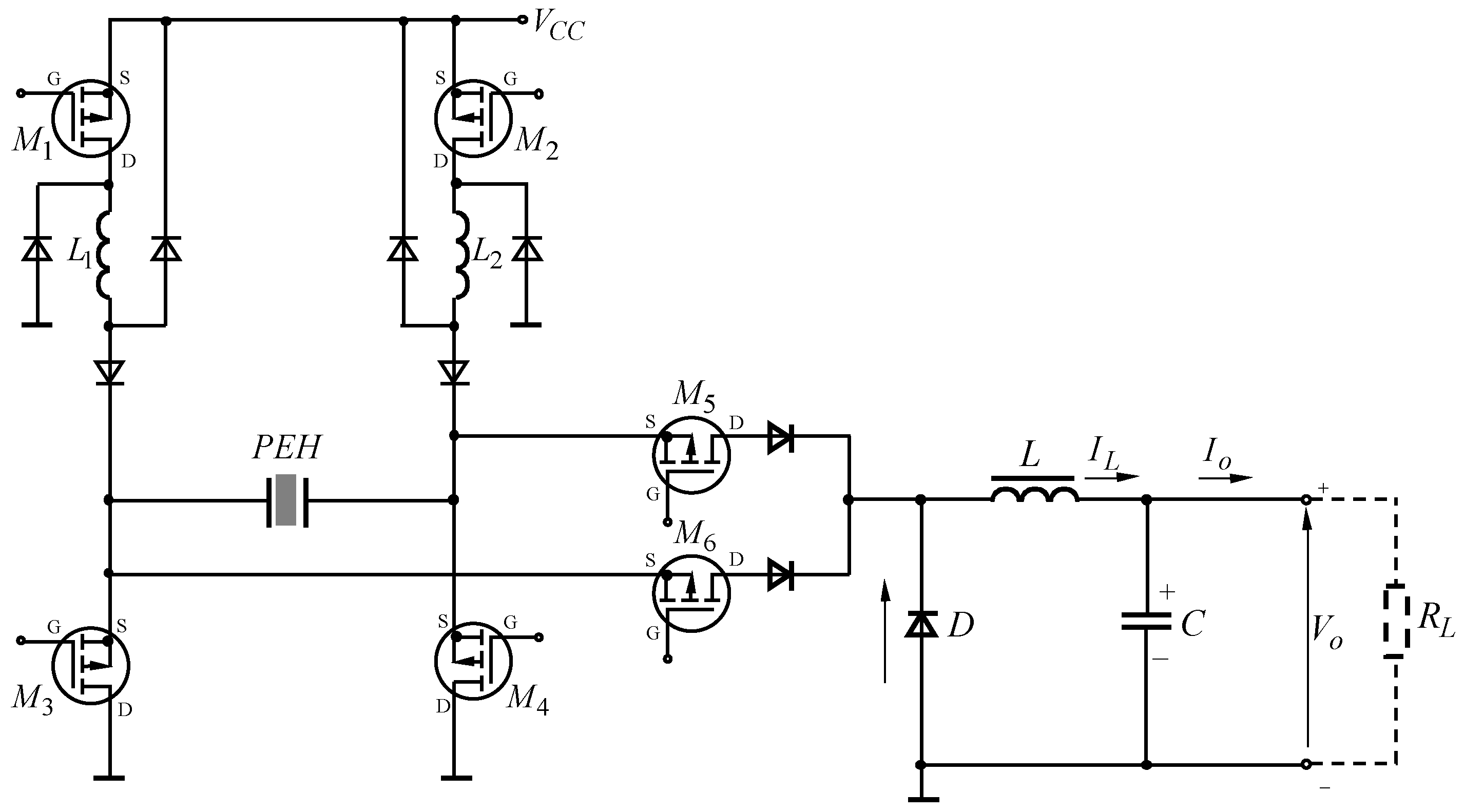

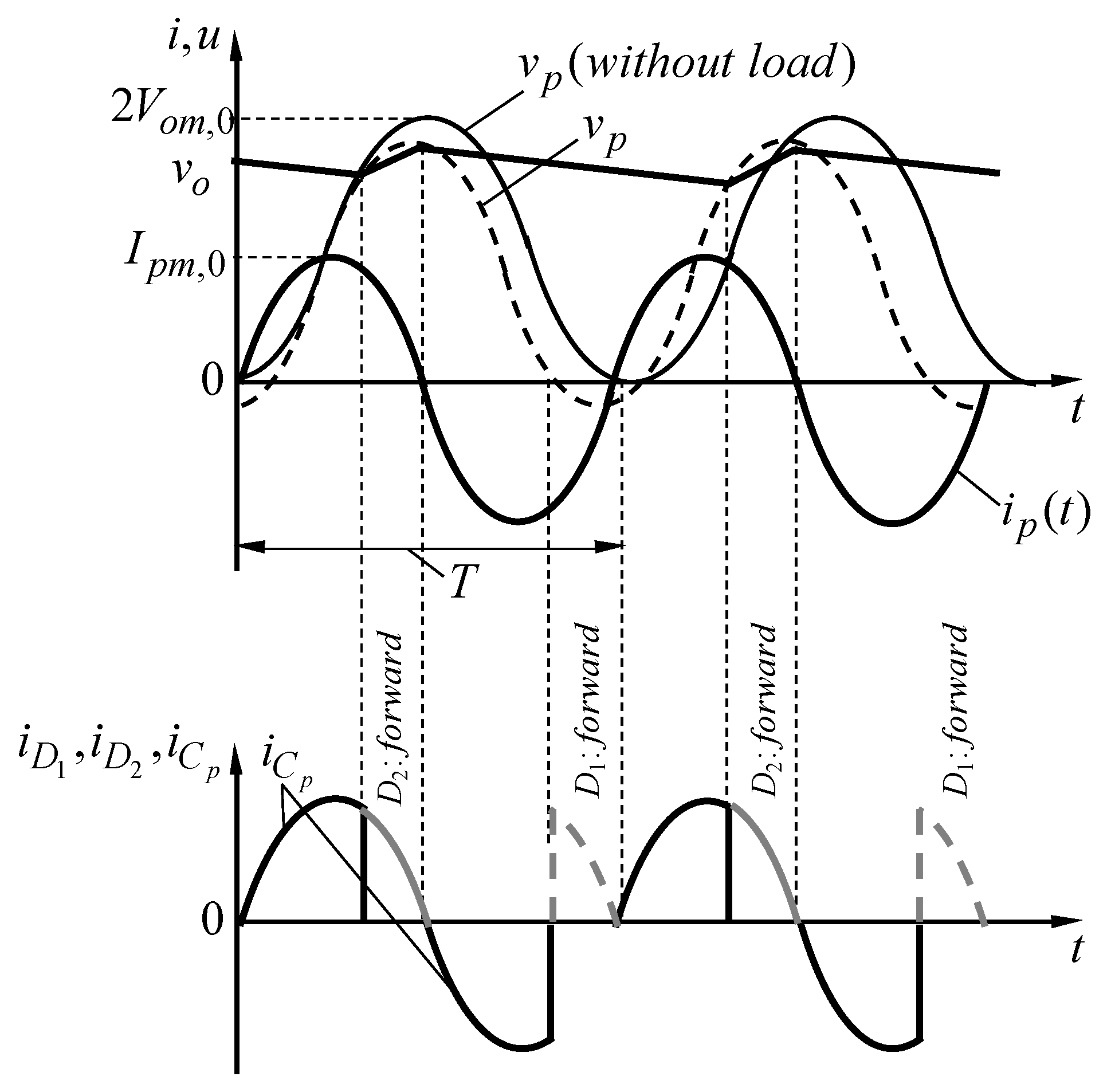
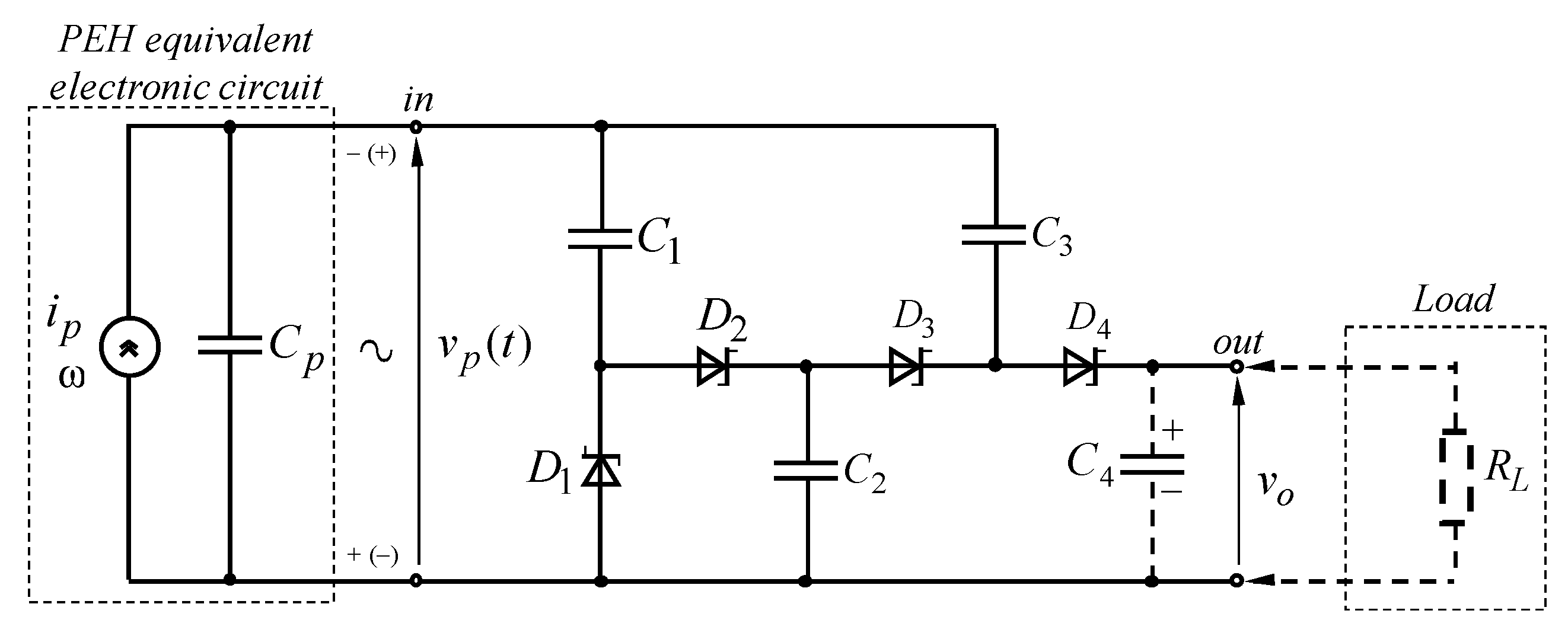
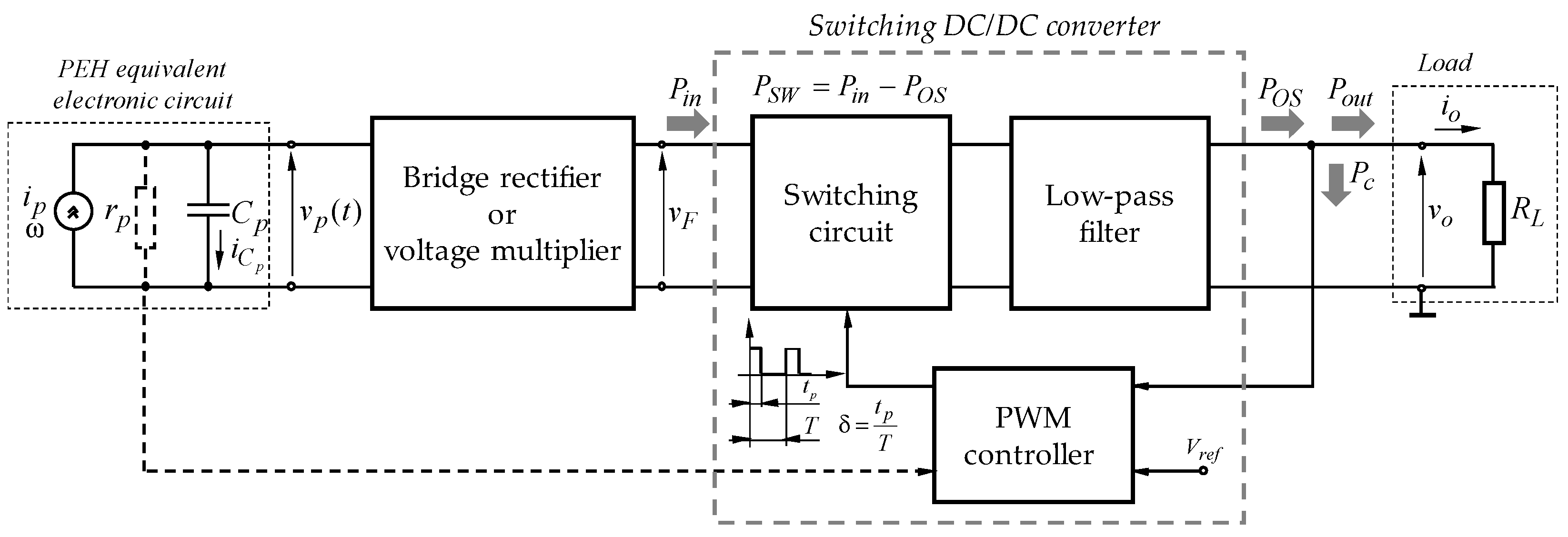

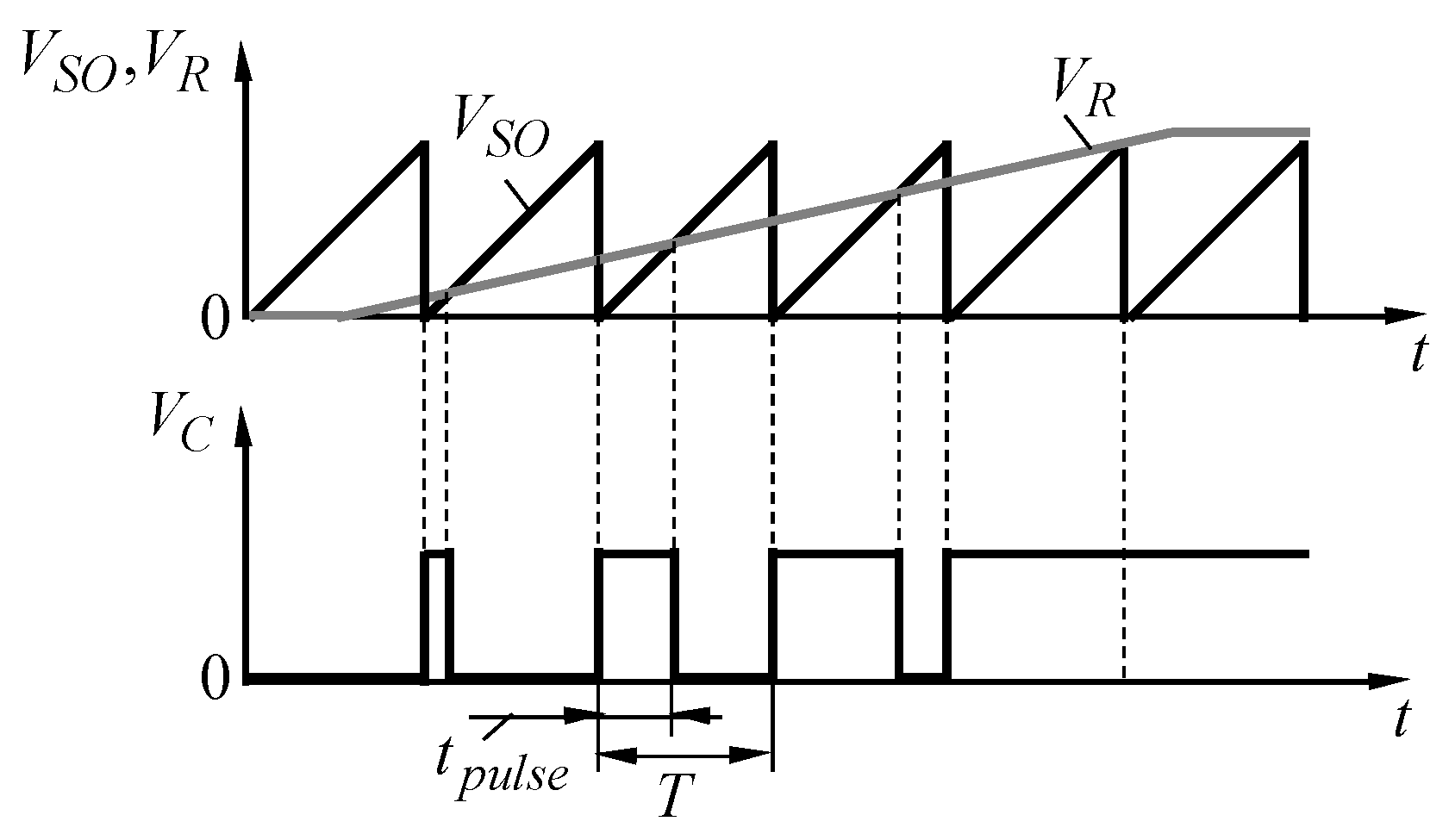
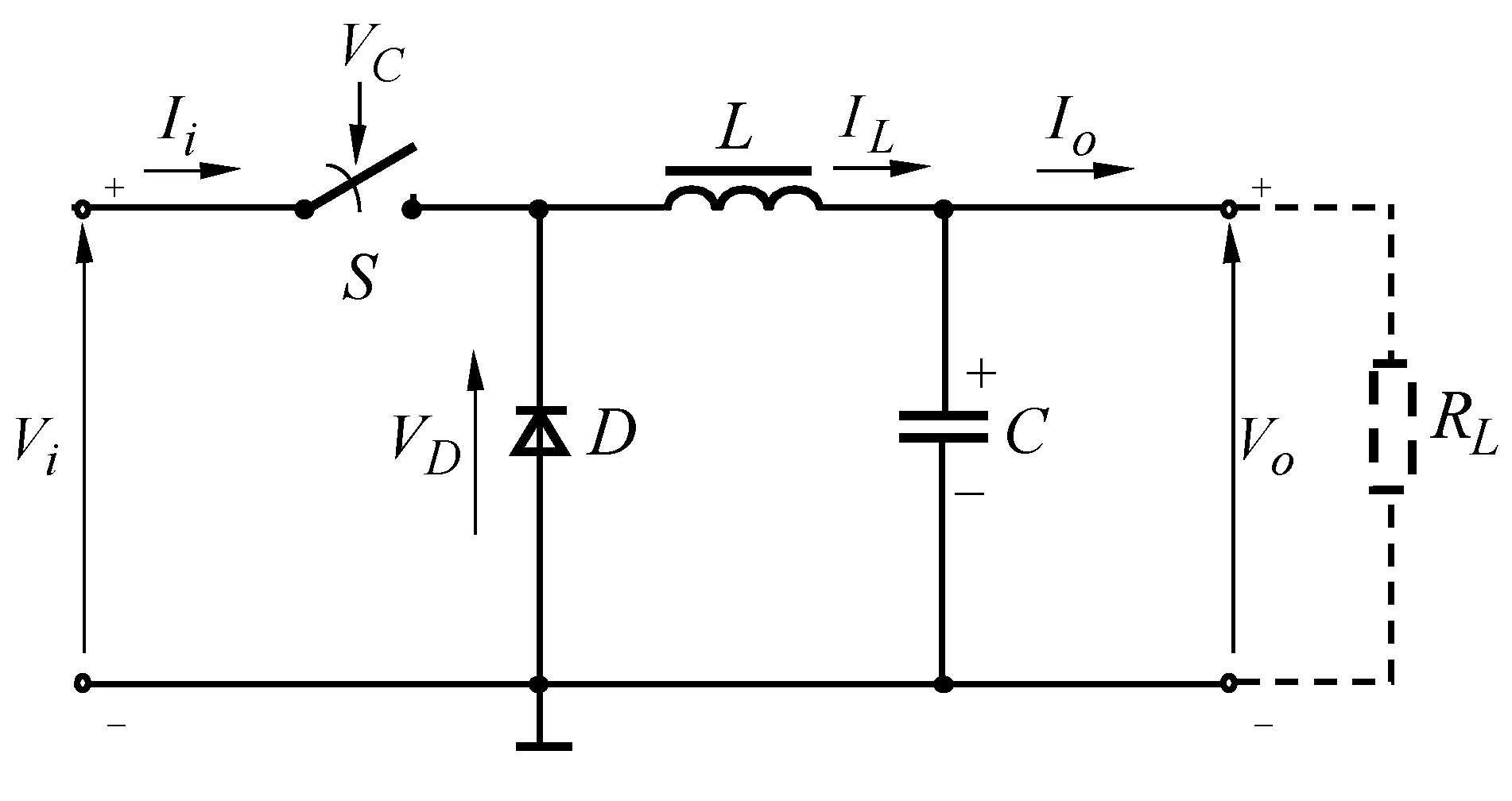

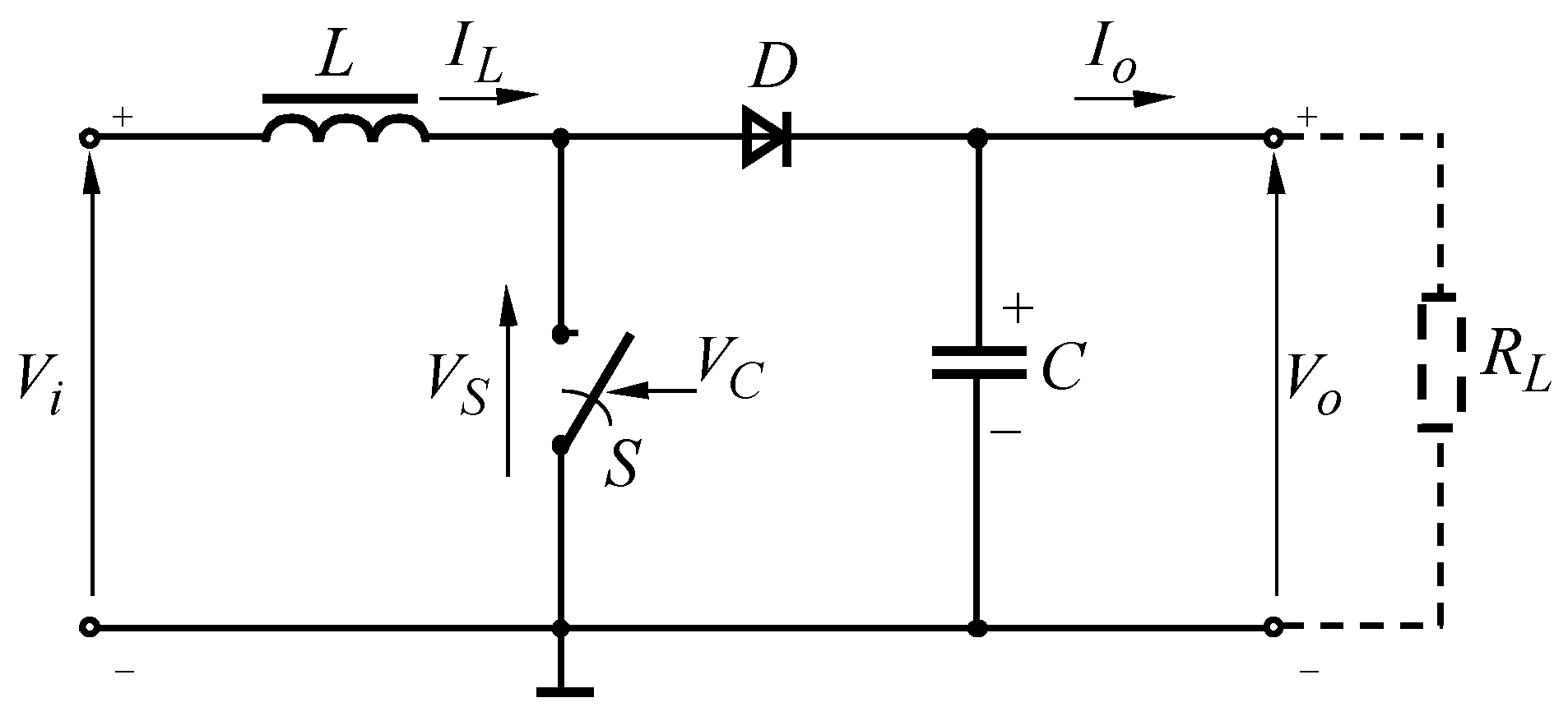
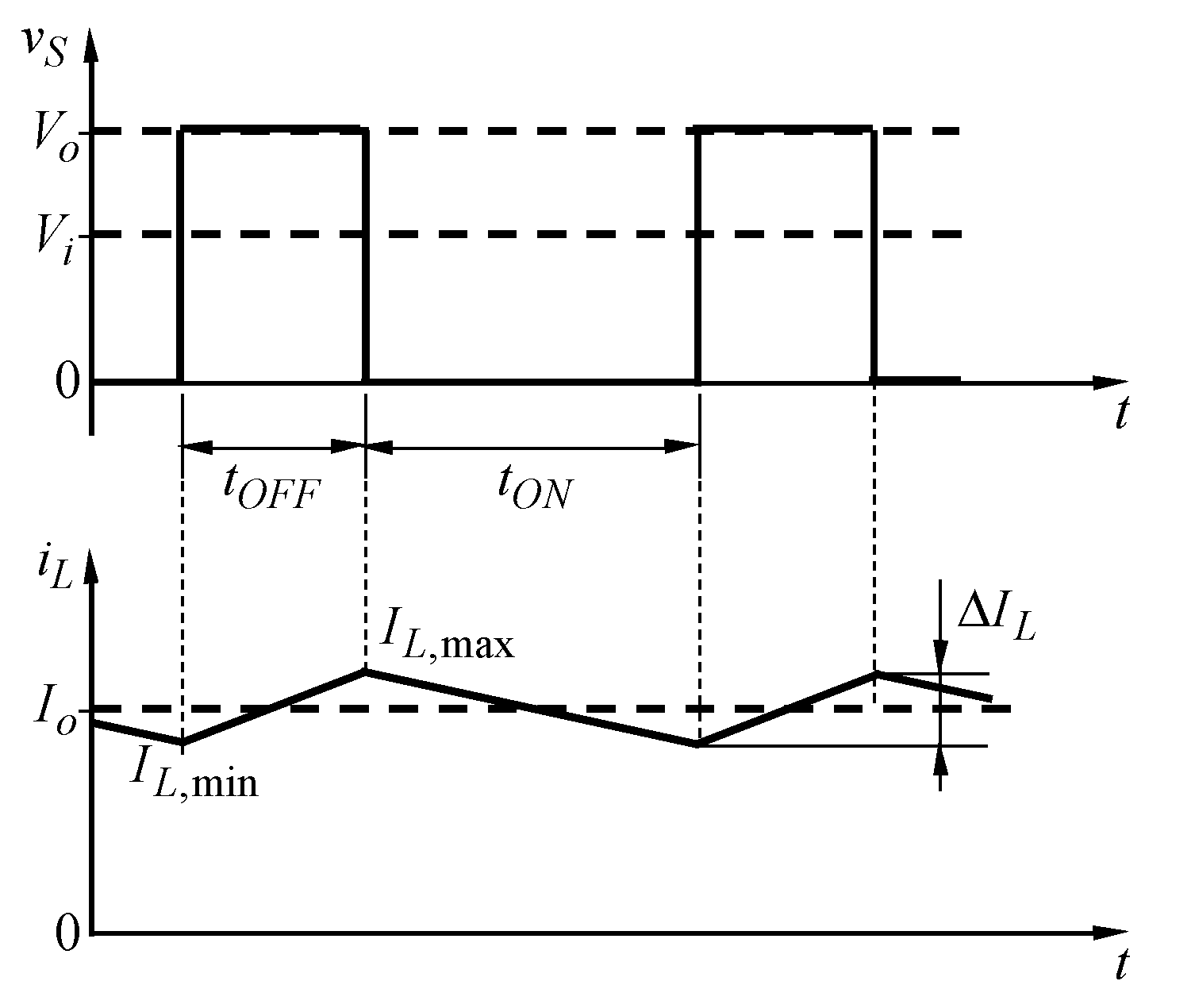



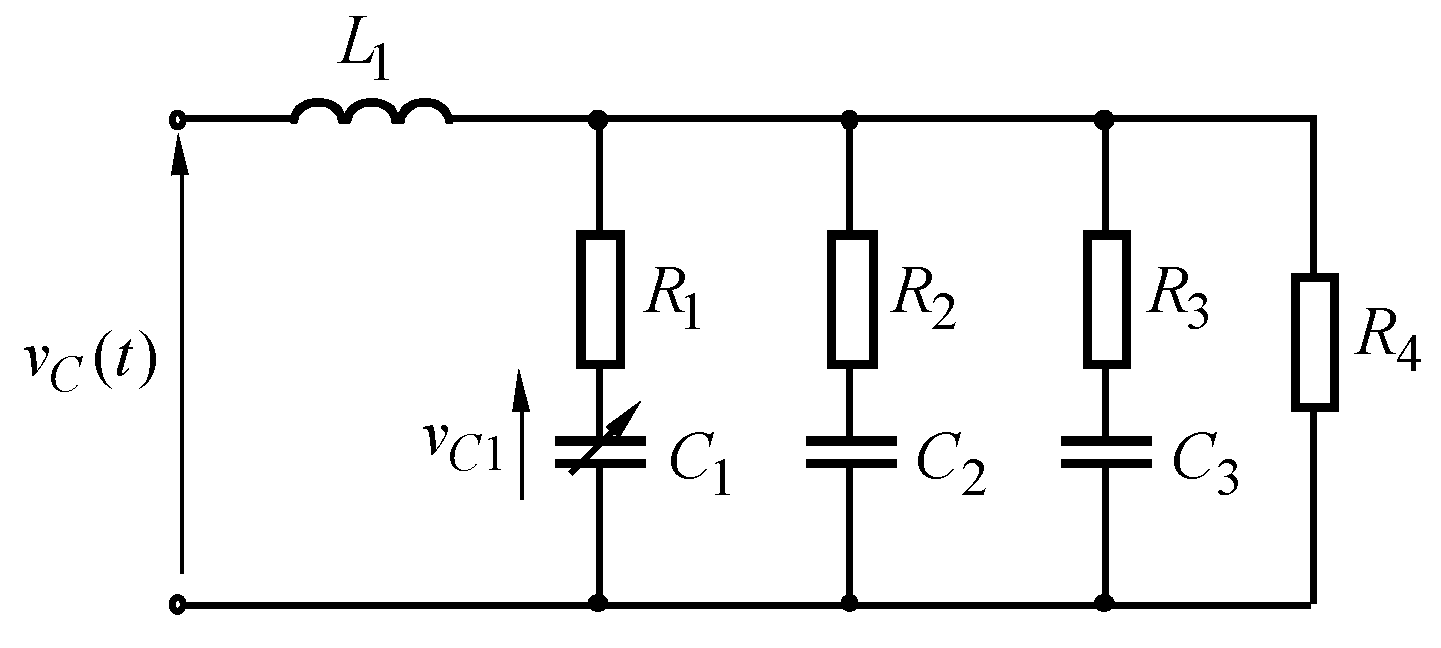
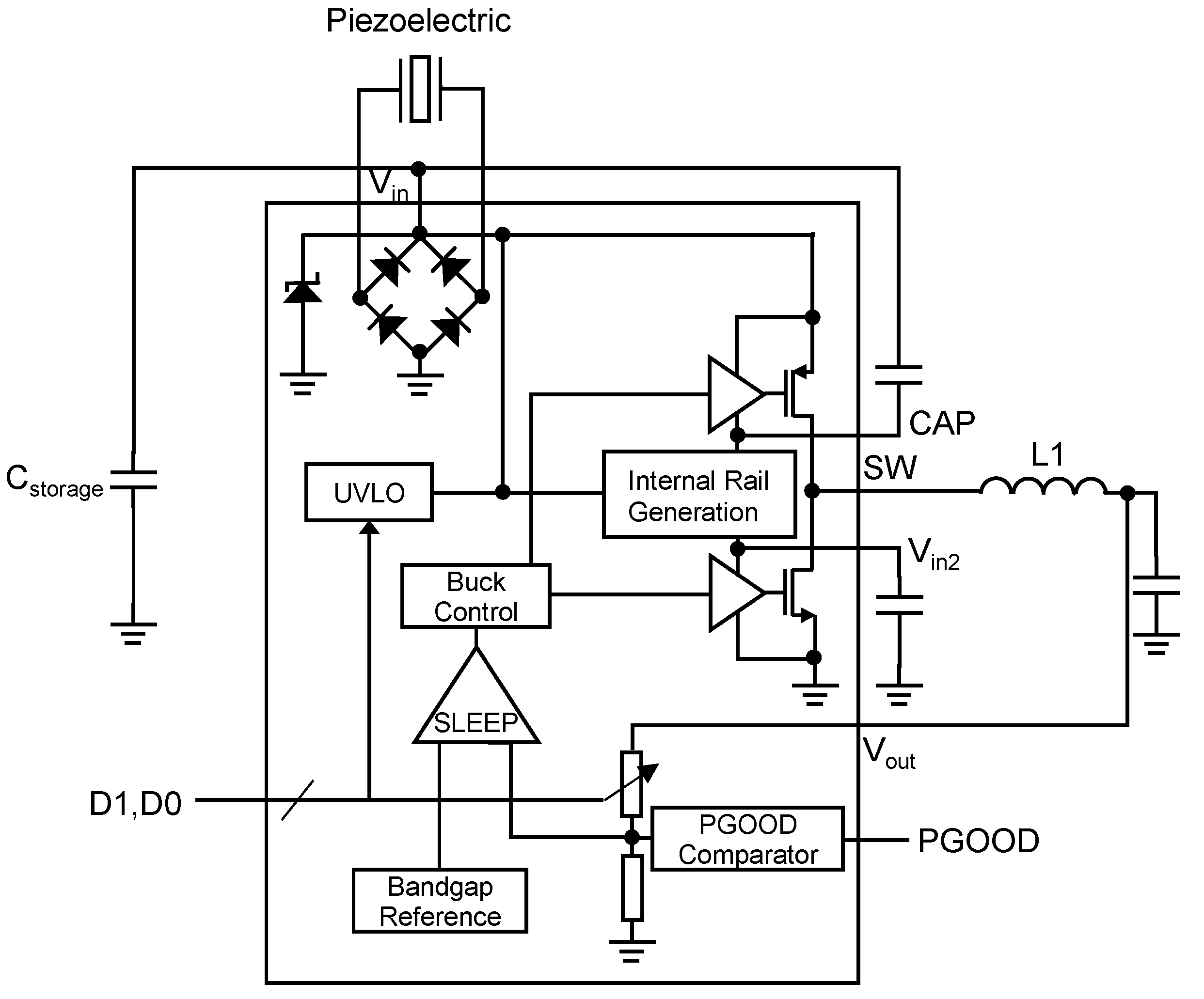
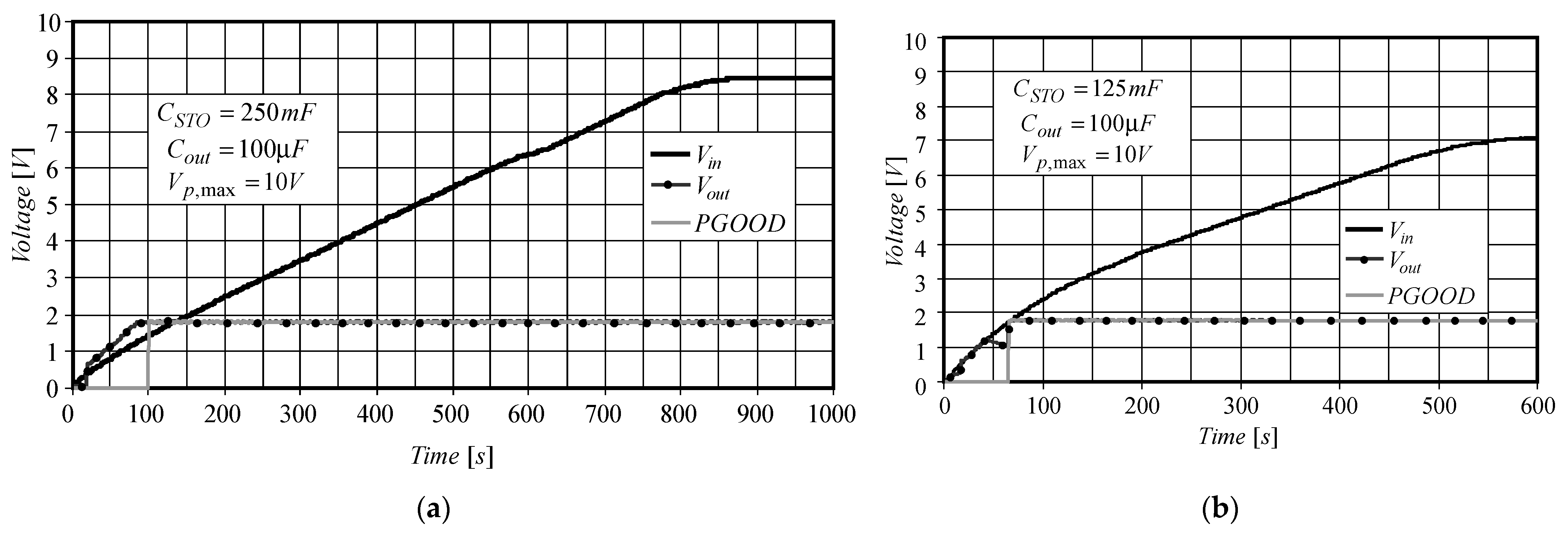


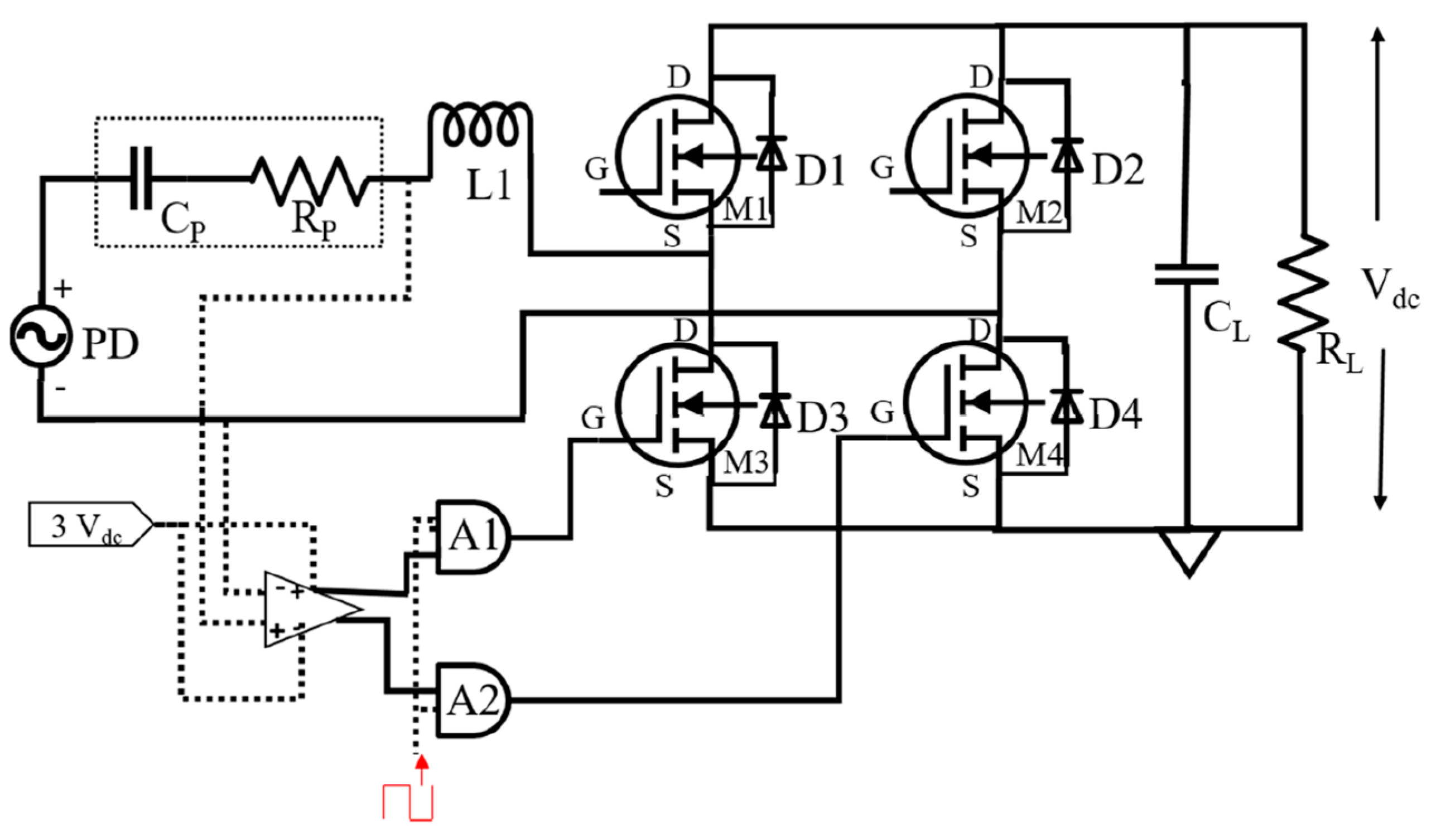

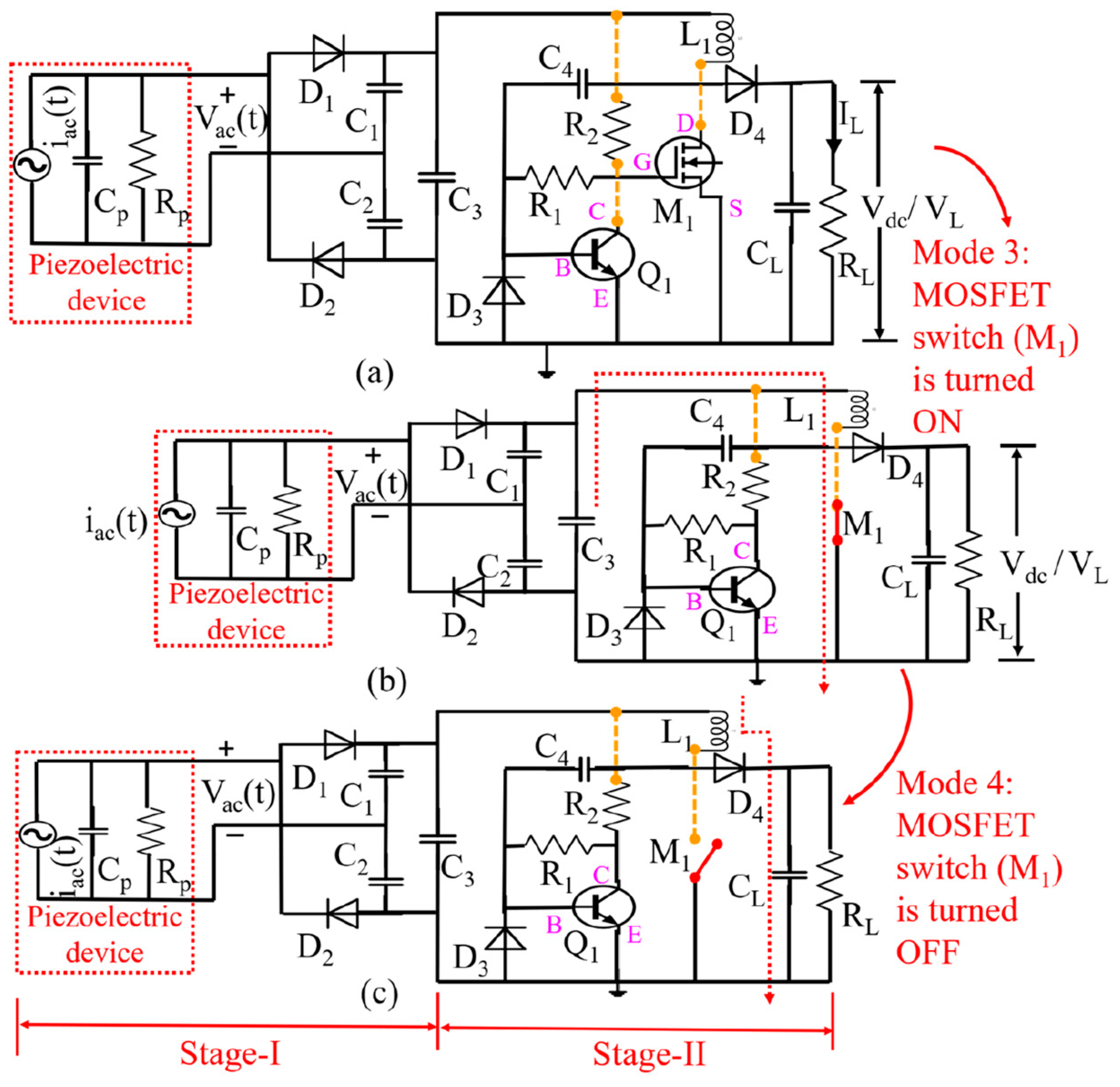
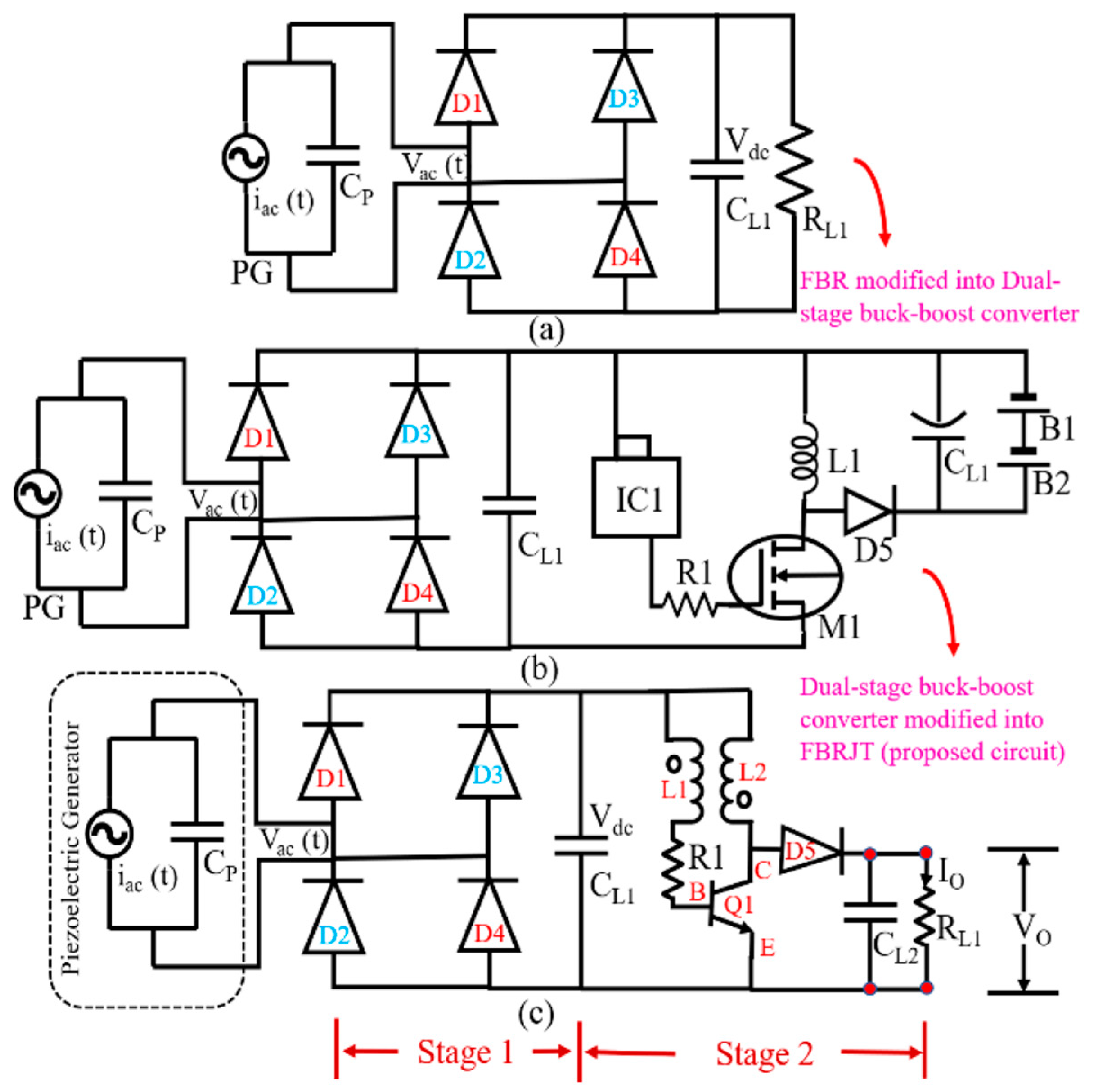
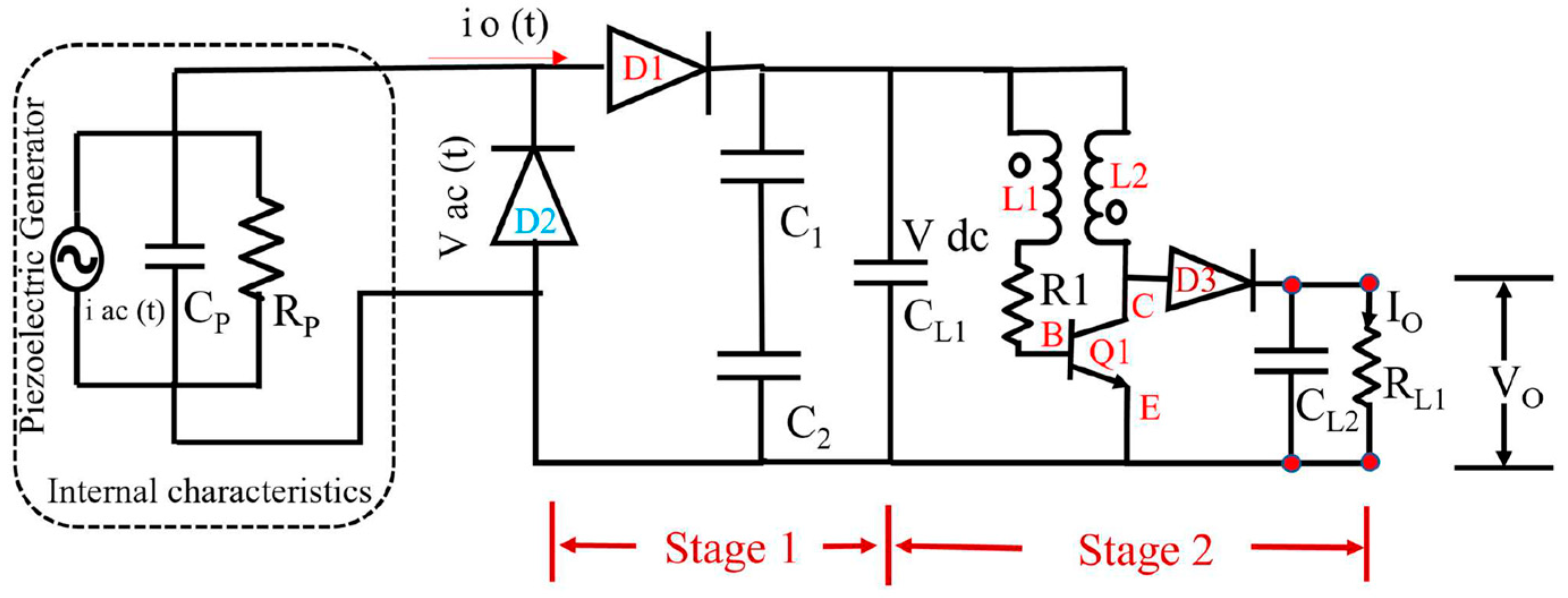

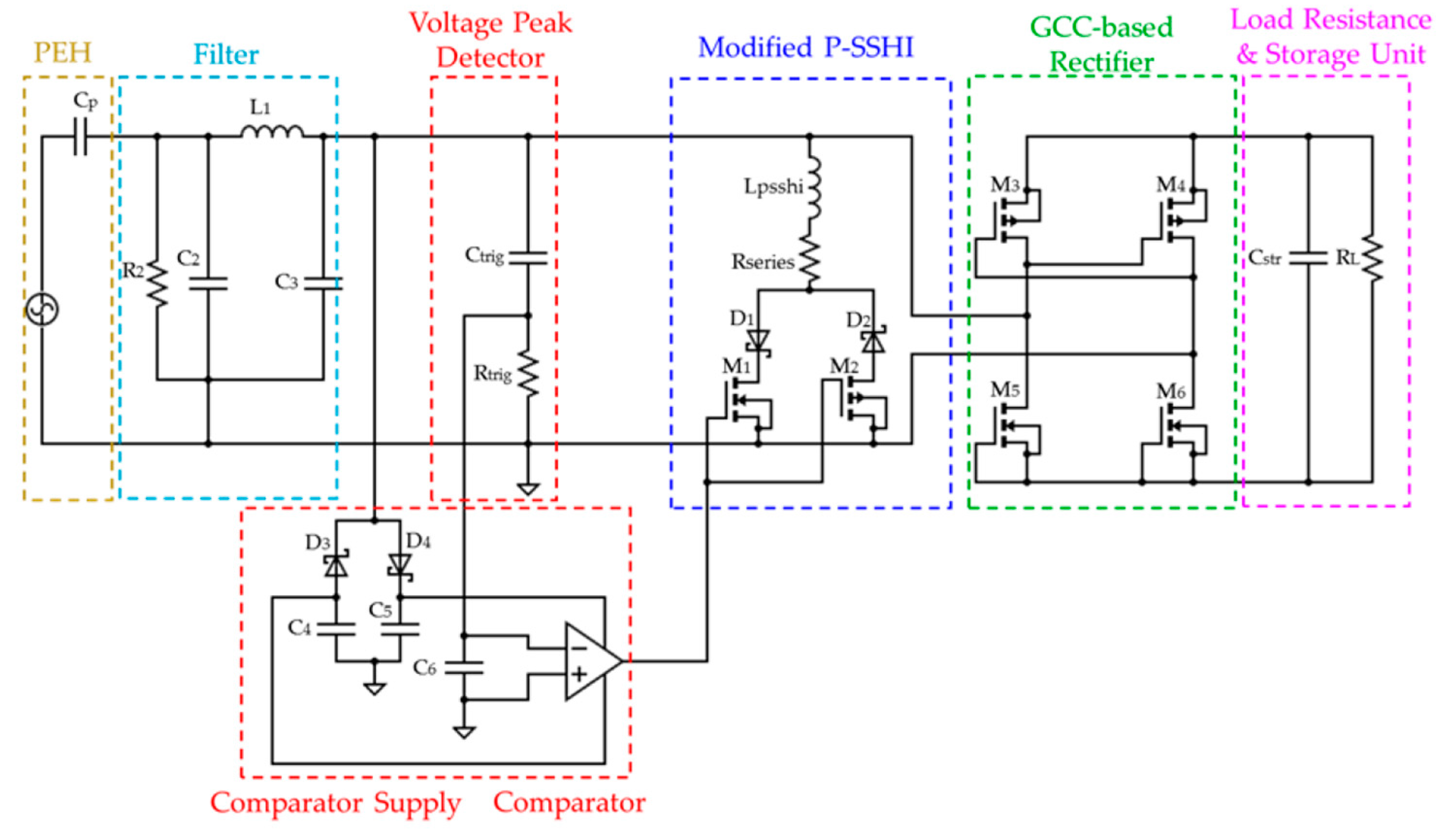
| Device | Approach | Modes of Operation /Topology | Input Power/Frequency (1) | Output Power | Efficiency | Application/Remarks | Year |
|---|---|---|---|---|---|---|---|
| INLSC [99] | Non-linear switching circuit (INLSC) | Eight possible modes; utilizes polarity detector for active rectification | n.a./ 100 Hz | >450 μW | - | Powers 7-segment display | 2022 |
| Modified Voltage Doubler [100] | Modified voltage-doubled boost converter | Six modes; minimized diodes for reduced forward voltage losses | n.a./20 Hz n.a./100 Hz | 1.368 μW 12.321 μW | - | Low-voltage applications | 2023 |
| Voltage Doubler with Boost [101] | Voltage doubler coupled with boost converter | Four modes; reduced number of switching elements | n.a./50 Hz n.a./1 Hz | 3.61 mW 0.396 mW | - | Improved power extraction at low frequencies | 2023 |
| Full-Bridge Joule Thief (FBRJT) [103] | Full-bridge rectifier with buck/boost converter | Six modes; optimized for low AC frequencies | 4.77 mW/ 10 Hz | 3.41 mW, 71.5% | 71.5% | Optimization for low AC frequencies and human movements | 2023 |
| Voltage-Doubler Joule Thief (VDJT) [102] | Voltage doubler based on FBRJT topology | Six modes | 7.6 mW/ 5 Hz | 5.5 mW | 72.3% | Higher output energy and efficiency compared to FBRJT | 2023 |
| Energy Harvester Power Optimizer (EPHO) [94] | AC-DC boost converter with control loop | Control loop emulates “negative” capacitance for increased power; delivers power under sinusoidal and non-sinusoidal conditions | n.a./232 Hz (sinusoidal) n.a/n.a. (non-sinusoidal) | 2.81 mW 1.19 mW | - | Control loop for enhanced power delivery | 2023 |
| Interface Circuit for Footstep [85] | Energy harvesting device for footstep applications | Consists of 4 main blocks, designed for footstep applications | 4.32 mW/ 1 Hz | 3.6 mW | 83.33% | Max efficiency achieved for capacitor charging | 2023 |
Disclaimer/Publisher’s Note: The statements, opinions and data contained in all publications are solely those of the individual author(s) and contributor(s) and not of MDPI and/or the editor(s). MDPI and/or the editor(s) disclaim responsibility for any injury to people or property resulting from any ideas, methods, instructions or products referred to in the content. |
© 2024 by the authors. Licensee MDPI, Basel, Switzerland. This article is an open access article distributed under the terms and conditions of the Creative Commons Attribution (CC BY) license (https://creativecommons.org/licenses/by/4.0/).
Share and Cite
Pandiev, I.; Tomchev, N.; Kurtev, N.; Aleksandrova, M. Analysis of the Methods for Realization of Low-Power Piezoelectric Energy Harvesting Circuits for Wearable Battery-Free Power Supply Devices. Appl. Sci. 2024, 14, 4792. https://doi.org/10.3390/app14114792
Pandiev I, Tomchev N, Kurtev N, Aleksandrova M. Analysis of the Methods for Realization of Low-Power Piezoelectric Energy Harvesting Circuits for Wearable Battery-Free Power Supply Devices. Applied Sciences. 2024; 14(11):4792. https://doi.org/10.3390/app14114792
Chicago/Turabian StylePandiev, Ivaylo, Nikolay Tomchev, Nikolay Kurtev, and Mariya Aleksandrova. 2024. "Analysis of the Methods for Realization of Low-Power Piezoelectric Energy Harvesting Circuits for Wearable Battery-Free Power Supply Devices" Applied Sciences 14, no. 11: 4792. https://doi.org/10.3390/app14114792






